Submerge With Me . . .
With GREAT thanks to Dawn Dudek for her support in reworking this slide show and to Hunter Molnar Stanton for her help with the first version.
With GREAT thanks to Dawn Dudek for her support in reworking this slide show and to Hunter Molnar Stanton for her help with the first version.
Rapturous. That’s a word I do not use easily, but it captures my feelings about today.
I saw the shimmering in the distance . . . Pacific Herring near the surface, scales reflecting the sunlight, the school mercurial, its members seemingly moving with a collective consciousness.
I hung back and tried to drink in the beauty. I knew my bubbles would disturb them and that I could therefore never capture the beauty in a photo.
But then . . . suddenly a river of flashing silver was streaming in my direction. Something had startled them on the opposite side of where I was. I held up the camera and repeatedly depressed the shutter release button while I lived the seconds of hundreds of herring bolting past. Then, they were in the distance again; a marine murmuration; the life’s blood of this ecosystem.
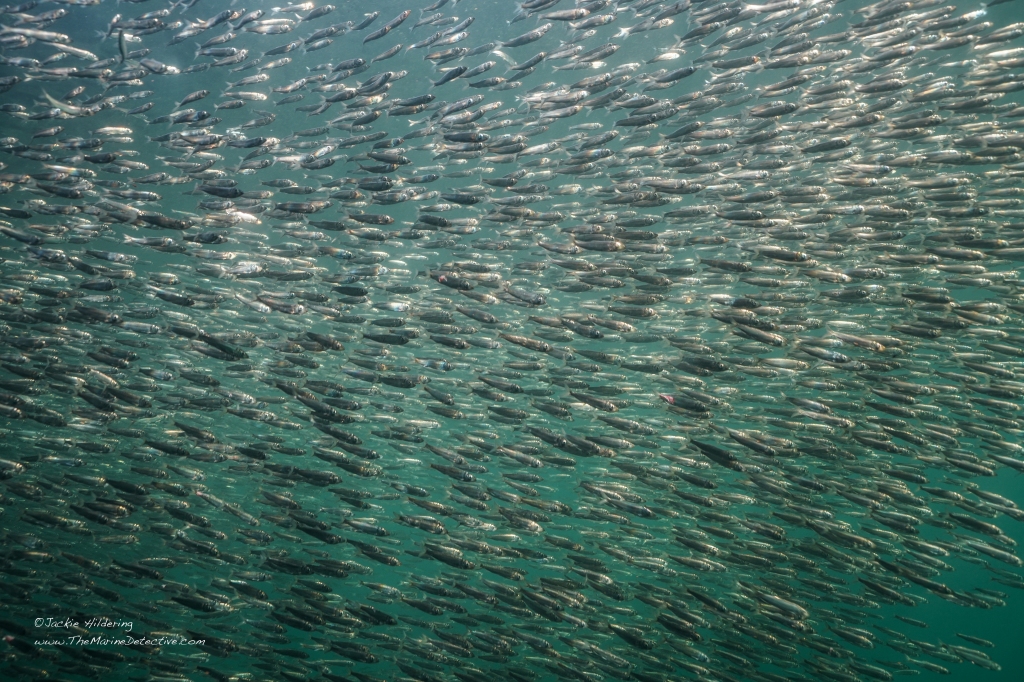
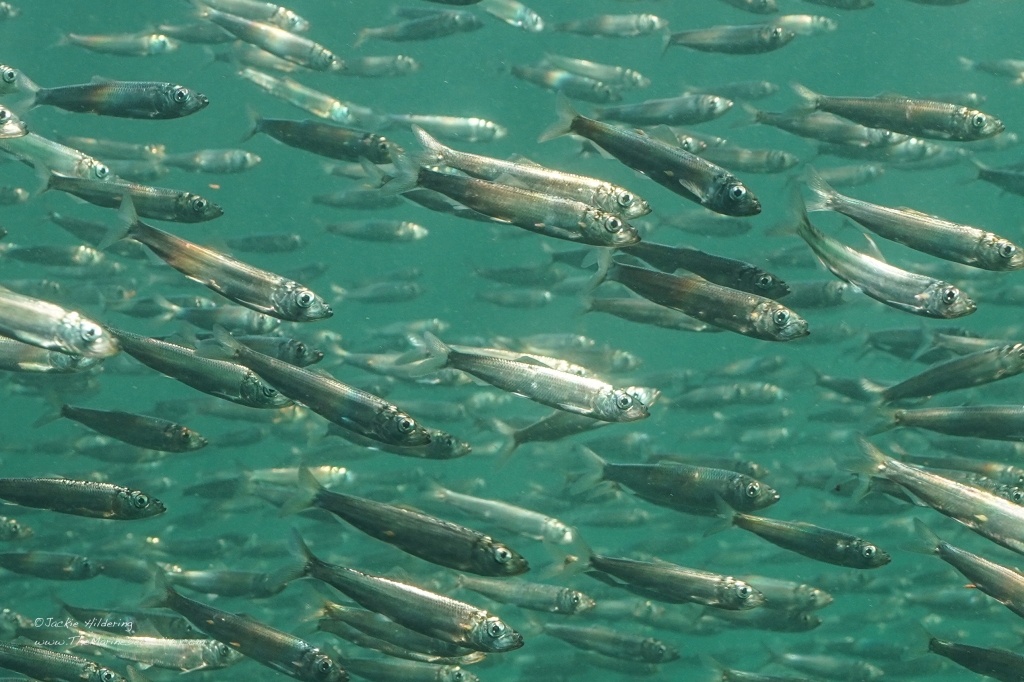
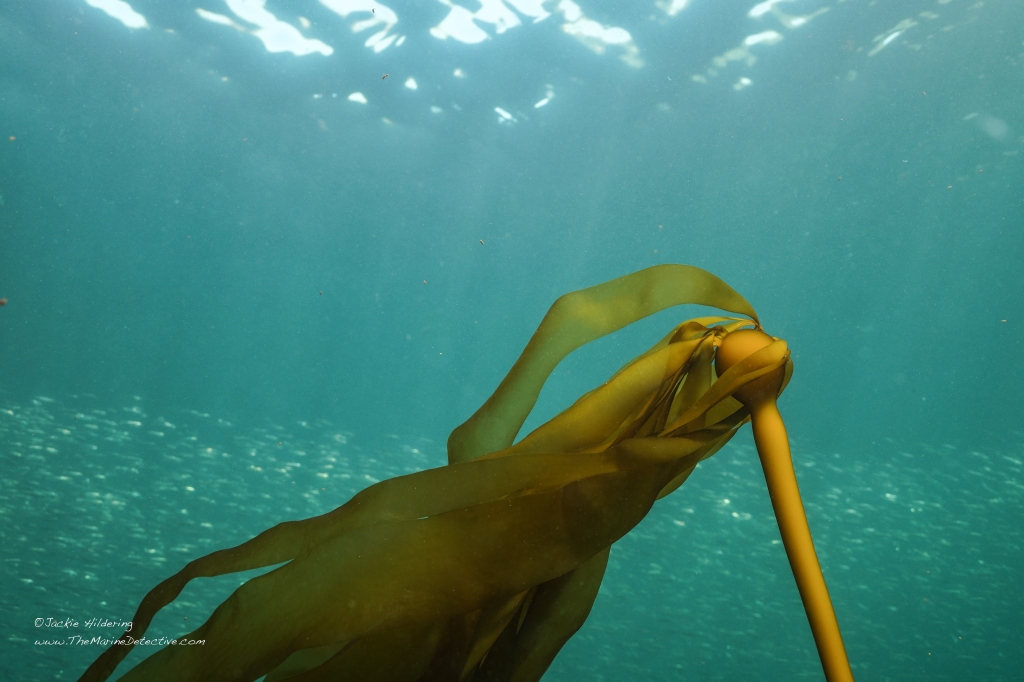
Survival against so many odds. These little fish have survived against so many odds and so vital to so much life on our coast; not just in the Ocean but also to predators from sky and land.
Shorebirds, bears and wolves feed on the fertilized eggs. Hungry Humpbacks target giant mouthfuls to gain back weight lost in the breeding grounds. Bald Eagles deftly snatch talons’ full and then feed in the air. The Pacific Herring also feed the Chinook Salmon that sustain endangered Orca.
They have also fed human cultures and commercial fisheries and debate and demonstration.
May the feed precaution and reflection on what will sustain future generations.
Long live herring.

A female Giant Pacific Octopus hunting . . . photos brought to the surface for you on April 4, 2021.
This individual lives north of Port Hardy, in Browning Pass.
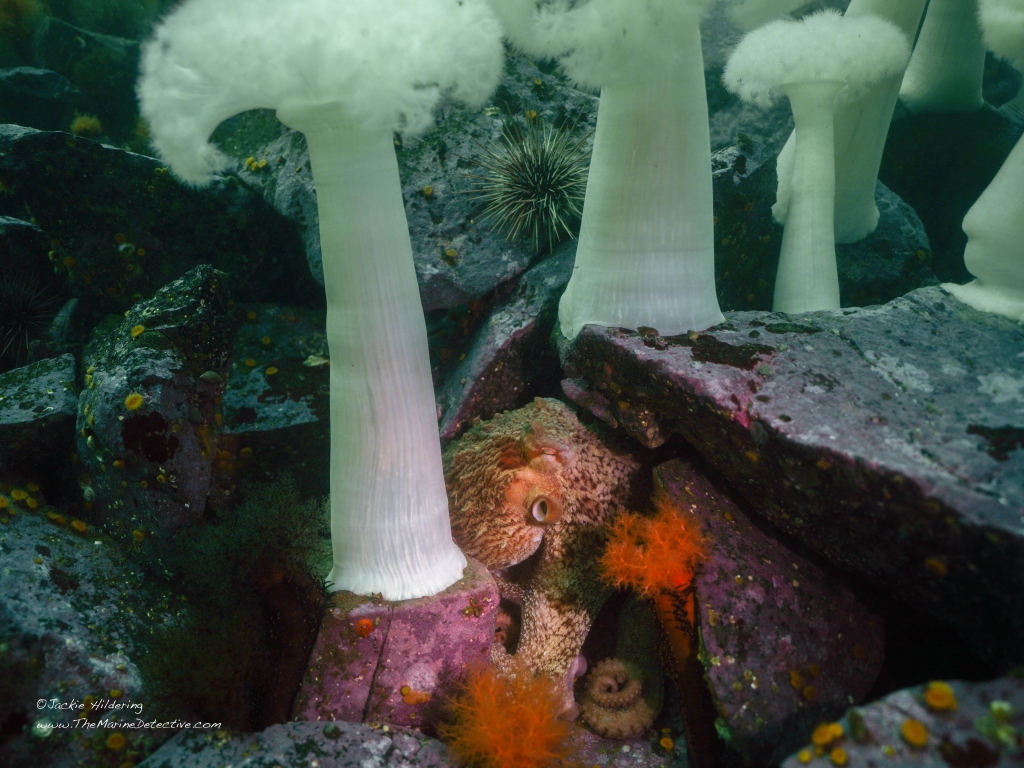
She’s a giant among other giants.
The Giant Plumose Anemones stand tall above her, at up to 1 metre in height.
Her arms feel between the rocks to flush out prey, her mind processing all she detects from her eight limbs, her vision, and the further stimuli upon her skin.
A China Rockfish is hovering nearby, likely often accompanying her when she is hunting to benefit from what prey emerges when touched by her arms.
Her colours change, flashing white at times. Then, again camouflaged among the boulders covered with the pink of coralline algae species, and studded with Orange Cup Corals and the plumes of feeding tentacles of Orange Sea Cucumbers.
Two humans are in awe at chancing upon her and being able to hover, navigating the space between not wanting to disturb and also wanting to amplify the wonder above the surface, hoping it somehow contributes to being better humans.
We’re aware too that we are limited by how much air remains in our tanks; the nitrogen building in our blood; and the cold creeping in through our dry suits (despite the adrenaline surge of watching her).
But she, she is limitless here.
She is perfection.


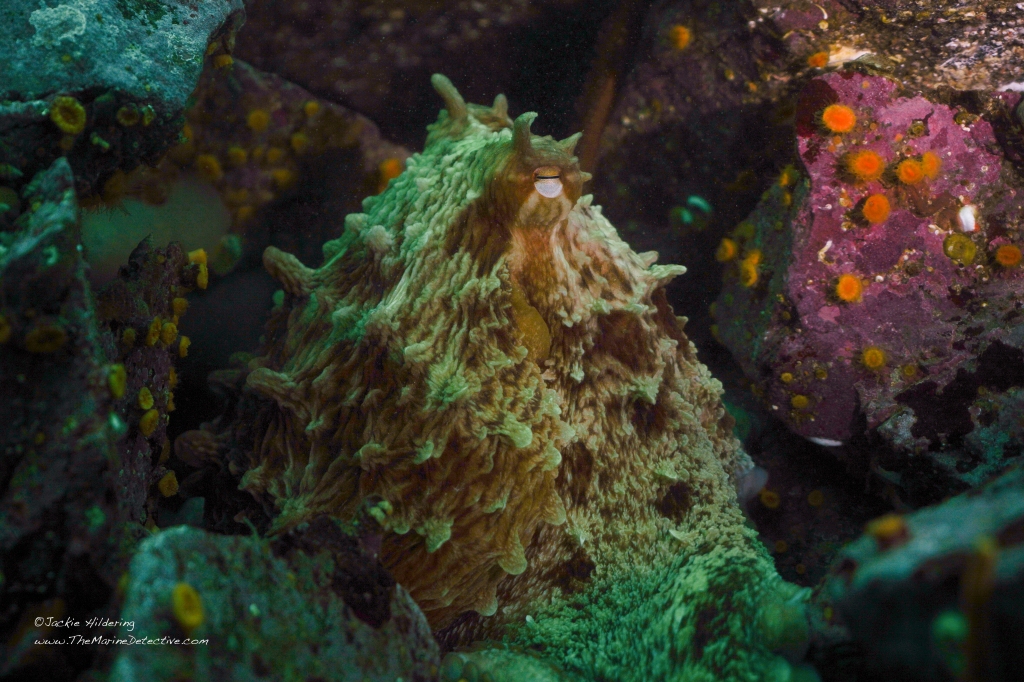
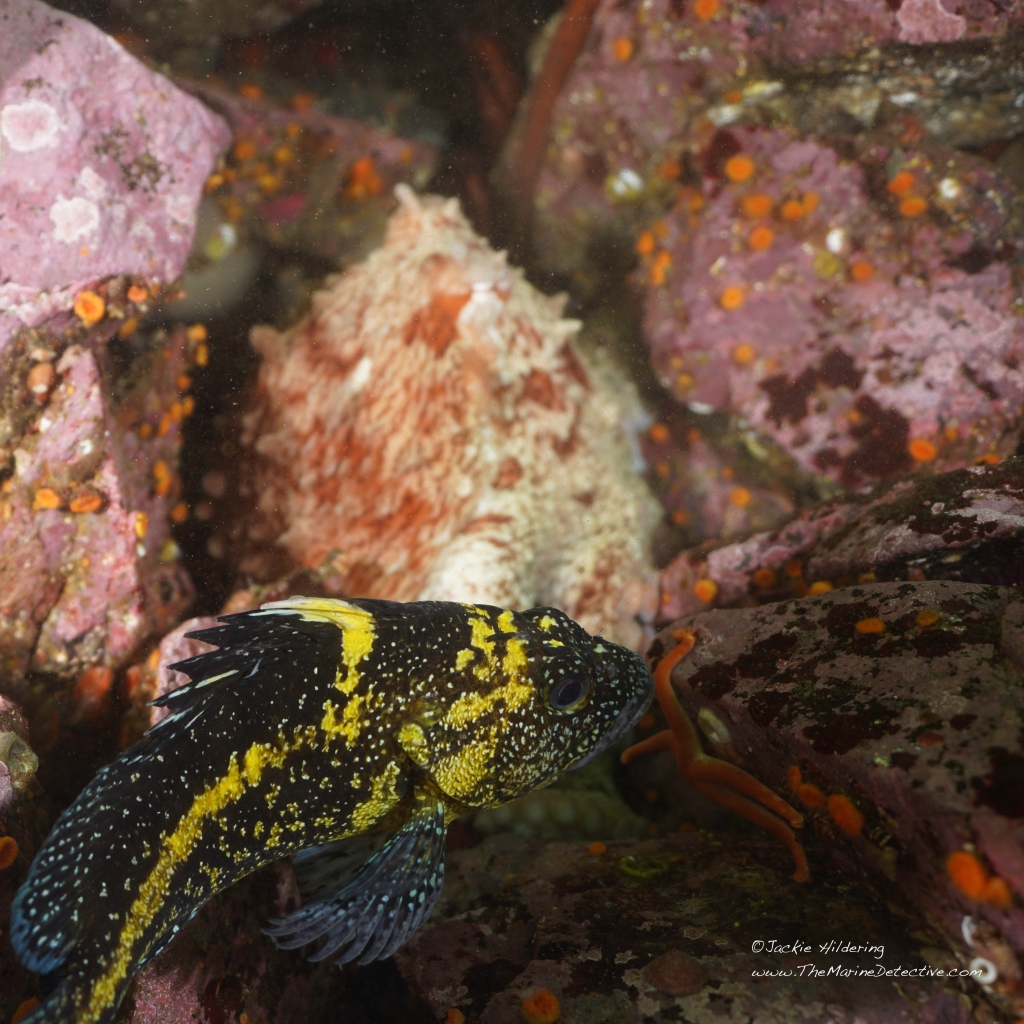
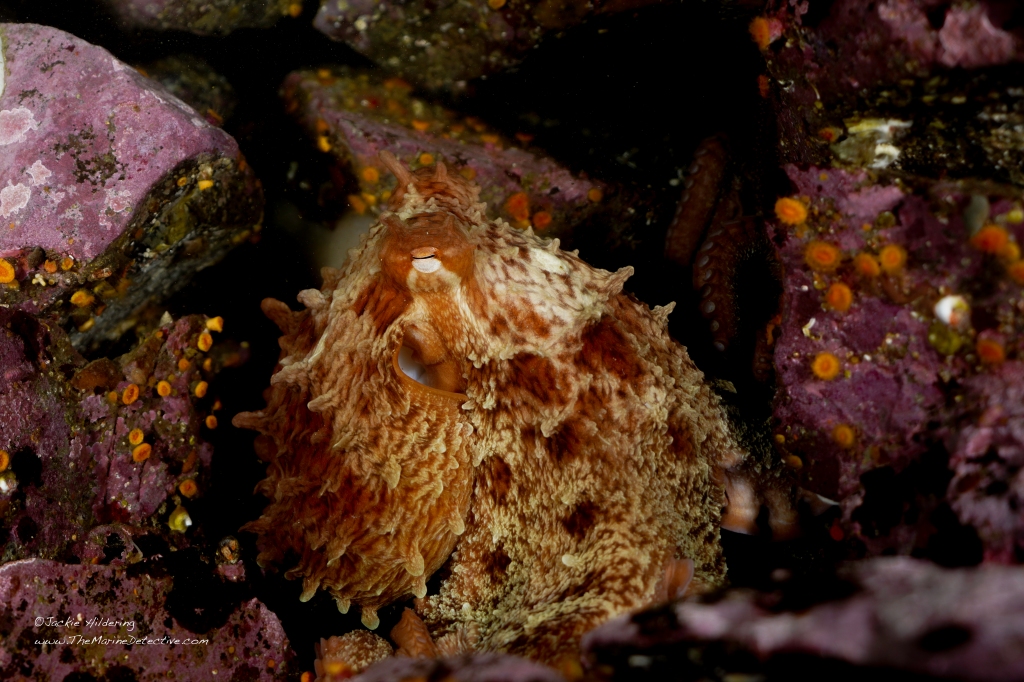

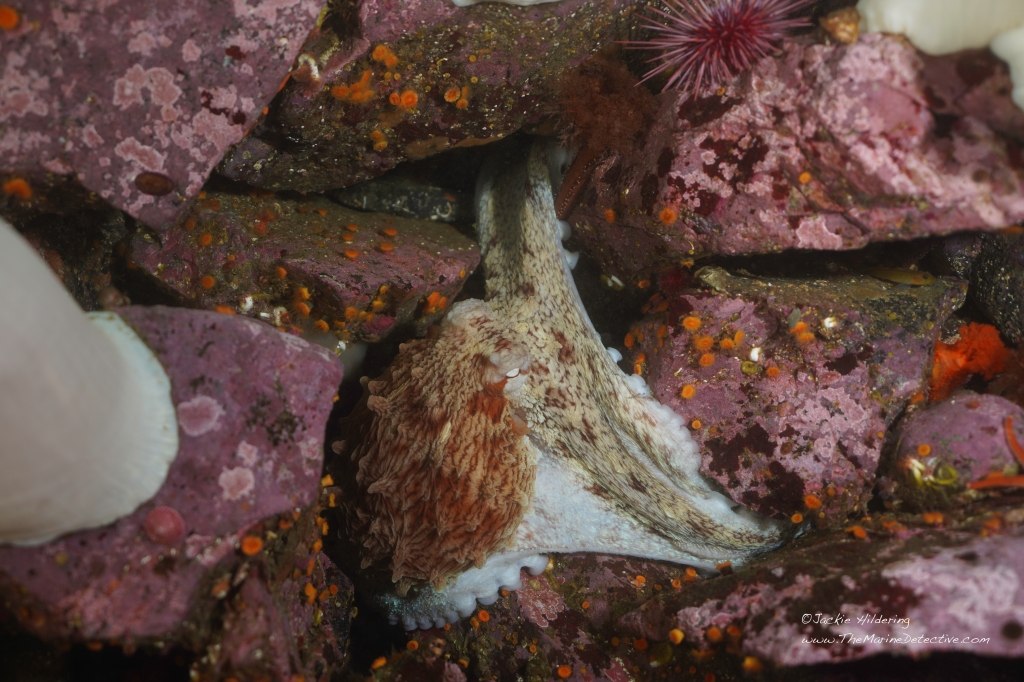
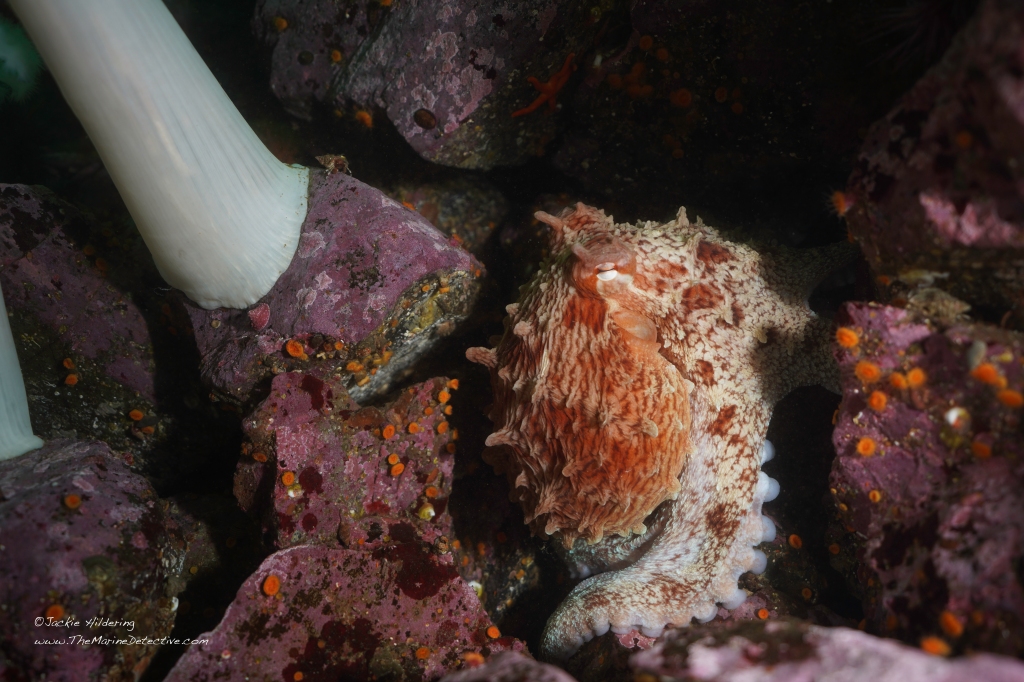
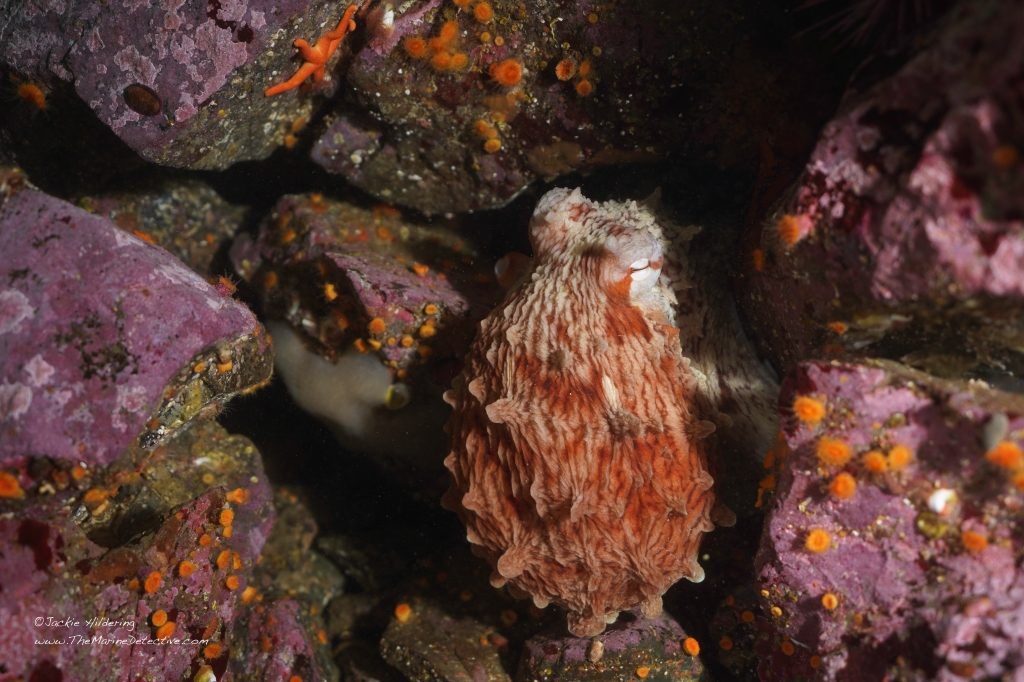
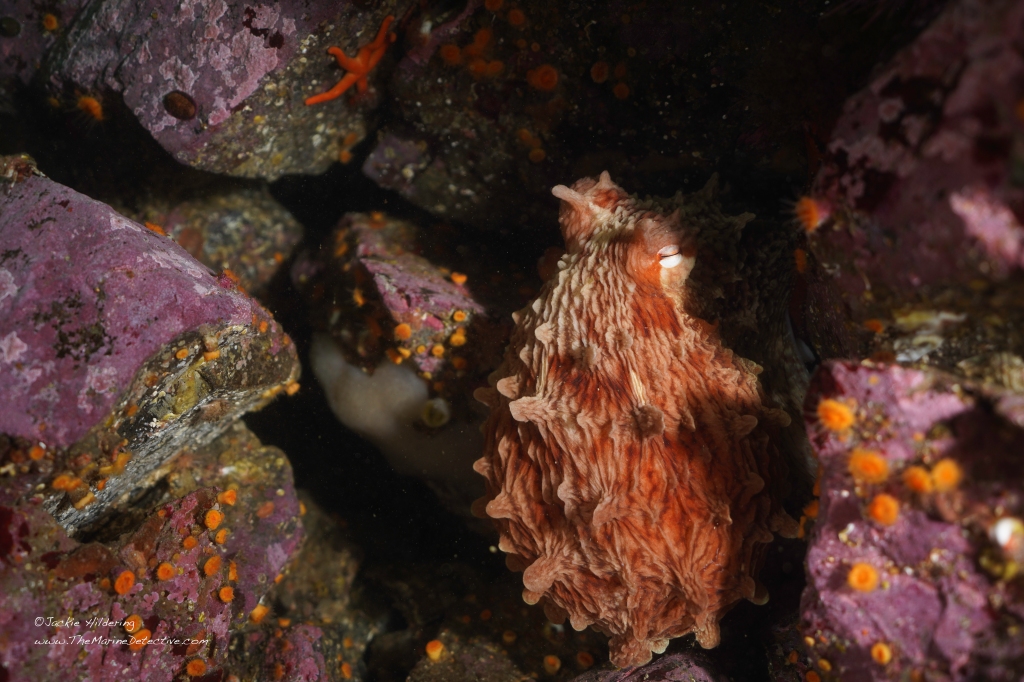
Octopus Gender:
I know this was a female because the third arm on the right does not have a “hectocotylus”. Male octopuses have a specialized arm with no suckers at the tip called the “hectocotylus arm” by which they hand off spermatophores to the female. In Giant Pacific Octopuses, the hectocotylus arm is the third on the right. See more in my recent blog “Giant Pacific Octopuses, How Do They Mate?” at this link.
Octopus Vision:
You can see that the pupil’s shape is very different from ours. Their retina is very different too.
Octopuses and other cephalopods have only one kind of photoreceptor cell while we have rod cells and three types of cone cells allowing us to see in colour. So how can cephalopods discern colour when they have only one kind of light receptor in their eyes? And they must be able to discern differences in colour. Consider how they signal with colour and how they camouflage.
Research from 2016 puts forward that their uniquely shaped pupils act like prisms, scattering light into different wavelengths (chromatic aberration), rather than focussing the light into a beam onto the retina. The hypothesis, tested with computer modelling, is that cephalopods can then focus the different wavelengths onto their retina separately by changing the distance between the lens and the retina, thereby separating the stimuli and discerning colour. Note that the sharpness of their vision is believed to be different for different wavelengths / colours.
Even with their eyes closed, octopuses can detect light with their skin. This is tied to their ability to camouflage with the photoreceptors in their skin responding to specific wavelengths of light (different wavelengths = different colours).
Note too that octopuses do not have eyelids. They have have a ring-shaped muscular fold of skin around the eye that closes in the way of an eyelid (especially when some annoying human is taking photos).
More Octopuses Hunting
Here’s the link to another experience where we saw a Giant Pacific Octopus hunting AND interacting with a Wolf-Eel (includes video).
Sources
Katz, I., Shomrat, T., & Nesher, N. (January 01, 2021). Feel the light: sight-independent negative phototactic response in octopus arms. The Journal of Experimental Biology, 224.
Stubbs, A. L., & Stubbs, C. W. (July 19, 2016). Spectral discrimination in color blind animals via chromatic aberration and pupil shape. Proceedings of the National Academy of Sciences of the United States of America, 113, 29, 8206-8211.
April 22nd.
It’s Earth Day. It’s also my birthday.
One of us is 4.543 billion years old. One of us in 58.
I’ll let you decide which is which. 🙂
So . . . it’s B-earthday.

And while everyday is an earth day for those of us on this blue planet, April 22nd is a day to increase resolve to live knowing our place IN the environment, because that’s where greatest well-being lies.
With this also being my birthday, maybe there is even greater reflection and taking stock – the lessons learned; the how-did-we-get-here; what has changed; what has not; the way forward; how much time is left . . . you know, the big stuff.
The privilege of reaching this age includes that there is more knowing of what has been, which helps inform how to move forward. There is greater understanding of the pushes and pulls on human values, and a greater ability to see over greater timelines, and know common solutions.
Yeah, my head does not spin as much at this age.
THAT was my clumsy segue to the following. For a long time, I’ve wanted to share “The Ark Video” which dates back to 1988. I found it so powerful at that time and believe it still has value and “deserves” to live on the internet, where it may still have positive impact.

The video features Dawn French as Mother Earth, scolding humanity, her children. You know Dawn French. She’s the fabulous British comedian of the “French and Saunders” duo, the “Vicar of Dibley”, the “Fat Lady in the Painting’ in Harry Potter, etc.
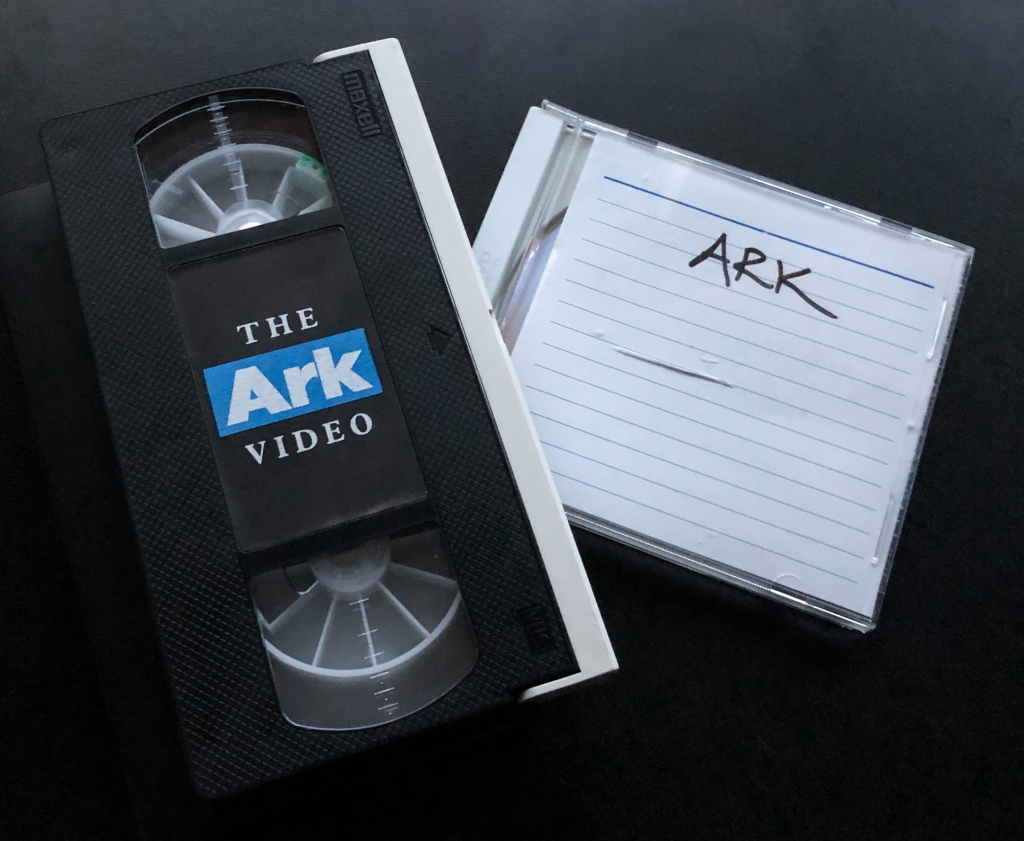
Look! The video is so old, it was on VHS and I had it converted to DVD. A reminder that 1988 was pre-internet and before most of us had computers.
There’s that reflection again: How quickly some things change, while others do not, and . . . why?
Watch the video with that in mind?
Note that the organization being promoted, The Ark Environmental Foundation, never proceeded with the promise this video provided. They faded out by the early 1990s. I don’t know why. There were big names involved. Kevin Godley of the rock band 10cc was the director of the video and I believe David Bowie was associated with Ark too.
Wanting words aimed at inspiring the way forward?
Please see my “Ocean Voice” post at this link.
For film details about The Ark Video, see this link.

Meet the Penpoint Gunnel, another fabulous fish face and master of camouflage.
The colour of Penpoint Gunnels varies as much as the colour of seaweed . . . from olive green, to golden brown to red. In fact, the colour of Penpoint Gunnels is generally such a perfect match to their seaweed habitat, that they sometimes seem to disappear into it. Presto – gone!
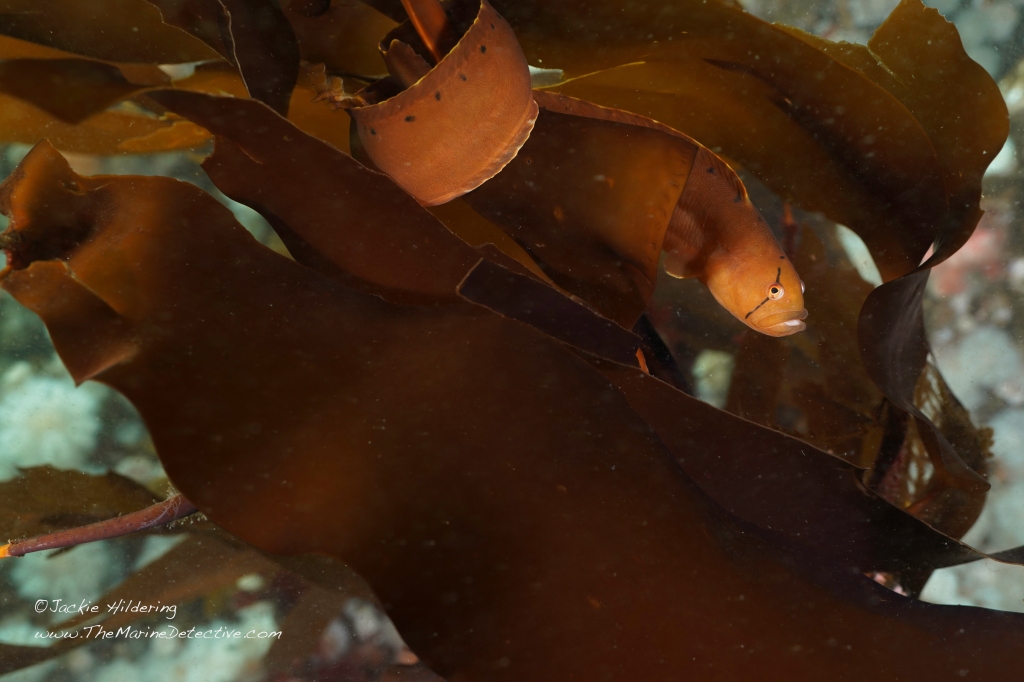
There’s a great paper from 1966 by Don Wilkie on the colour of Penpoint Gunnels. An interpretation of the paper by FISHBIO includes: “The coloration of adult penpoint gunnels typically matches the dominant algal community of their habitat. Green individuals are found in the upper intertidal zone where green algae (and eelgrass) is most common, brown specimens most frequently occur in the mid-to-lower intertidal zone where brown algae mainly occurs, and in deeper water where red algae become increasingly prevalent, penpoint gunnels tend to be red as well.”
Here’s a mystery. Penpoint Gunnels CAN’T change their colour to match their surroundings. So how can they have the variety of colour and be so well-matched to their habitat, as is evident in my photos below? Read on!
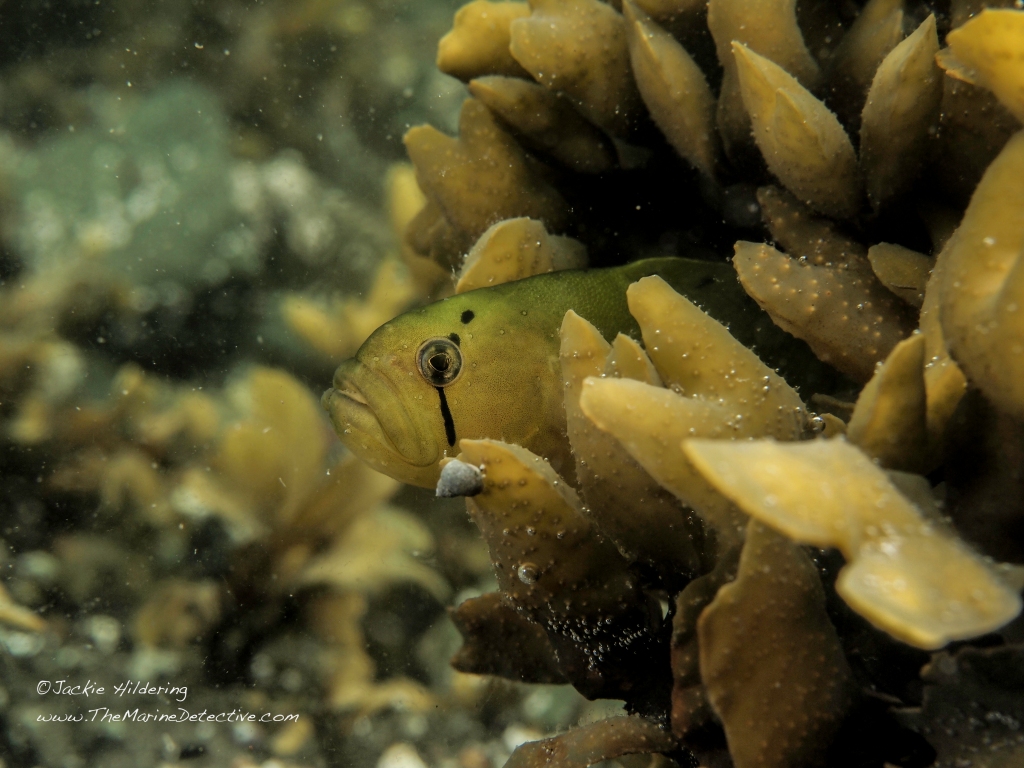
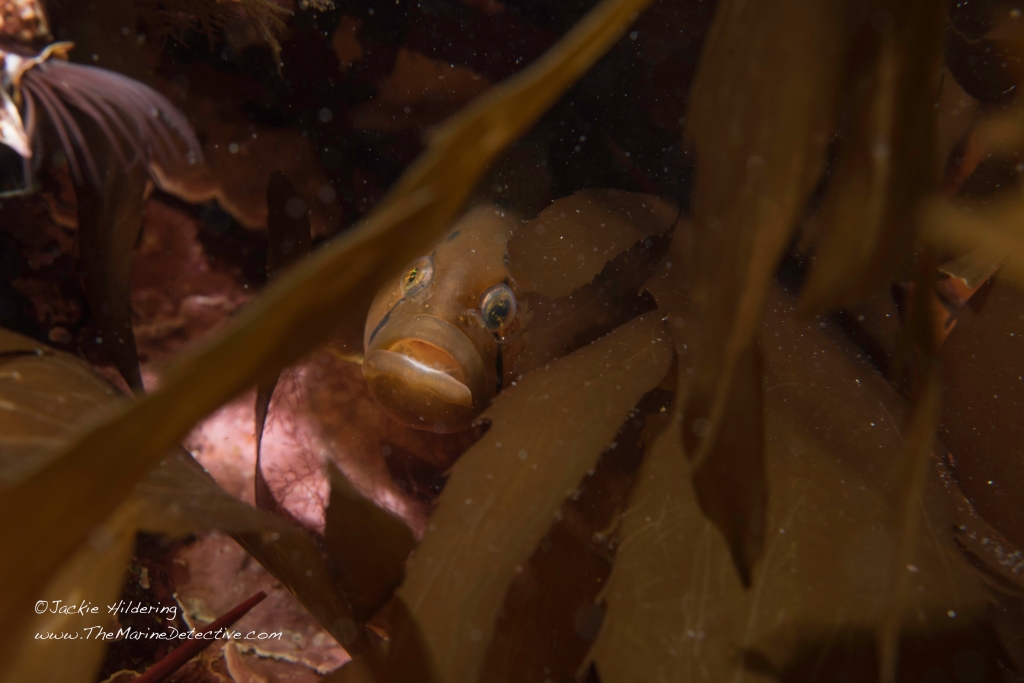

How can they be such a match to the algae when they cannot change their colour? Is colour determined through the genetics of their parents? Research suggests not! Is it determined by their diet when they are adults? Also no!
It appears that the colour is determined by (1) the vegetation upon which the transparent / colourless larvae settle and/or (2) by which amphipods the larvae eat.
From Wilkie: “Field and laboratory studies were undertaken to examine the ecological role of colouration in the penpoint gunnel Apodichthys flavidus . . . A. flavidus was found to prefer cover under rocks to that within vegetation, but when provided with vegetation alone chose that which it matched. The colour phases observed in A. flavidus were found to be determined directly by the pigments they contained not by differences in stages of chromatophore expansion . . . . Colour change experiments showed that A. flavidus cannot undergo complete changes of colour phase in response to environment alone. Diet has an influence on colour, but complete colour changes were not produced experimentally.
Larvae were reared from the eggs of green and brown individuals. All developed colouration more similar to that of the Artemia [brine shrimp] upon which they were fed than to their parental type . . . It is suggested that the colouration of A. flavidus has a cryptic function which is of importance primarily during food seeking. It is hypothesized that the vegetation upon which A. flavidus larvae settle in conjunction with early diet primarily determines the colouration of individuals.“
So, while Penpoint Gunnels cannot change colour, they appear to be able to recognize and select the vegetation for which their colour is a good match. What this also suggests is that the depth where an individual started of his/her life as a larva, will be the depth where they would/should live out their life.
As described above, because of the limits of how deep wavelengths of light can travel, there are zones of seaweeds / algae. Green seaweeds are in the shallows, then there are brown seaweeds, and then red seaweeds are the deepest (their pigment can best absorb the blue-green light that can penetrate to greater depths). If a Penpoint Gunnel started off as a larvae feeding on amphipods that are well-matched to green seaweed, the research supports this is what would make them green coloured. If that individual moved deeper into the brown or red zone, they would not have the appropriately coloured seaweed to match their colour.
It can be wonderfully difficult to discern Penpoint Gunnels from the other gunnel species off the coast of British Columbia (6 species total).
If you get a really good look at the back end of a Penpoint Gunnel, that really helps in IDIng the species. The “penpoint” refers to the first spine of the anal fin. It’s large and grooved like a fountain pen point. Yes, I know that most often that ID tip is not really going to help with a live individual. 🙂

I find it the most difficult to discern Penpoint Gunnels from Crescent Gunnels (Pholis laeta to 25 cm) and Saddleback Gunnels (Pholis ornata and 30 cm). Those species also have a wide variety in colour and have the black bar by their eye and, Penpoint Gunnels also can have markings along their backs. I don’t believe it is known how their colour of Crescent and Saddleback Gunnels is determined.
Then there are also Rockweed Gunnels, Longfin Gunnels, and Red Gunnels off the coast of British Columbia. Oh, and there are other elongate fish found in similar habitats, like species of prickleback and cockscomb!
The next six photos are included to maybe help with IDing gunnels. They are all NOT Penpoint Gunnels.
Then, at the end of the blog, there’s a fun fishing finding venture for you.
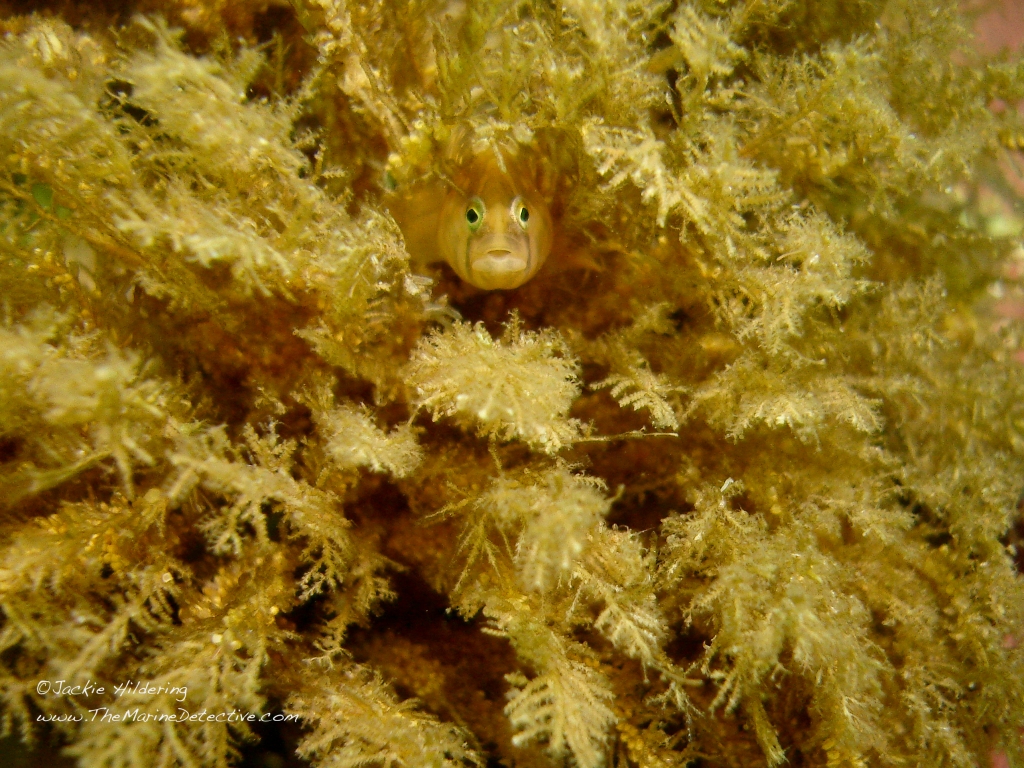
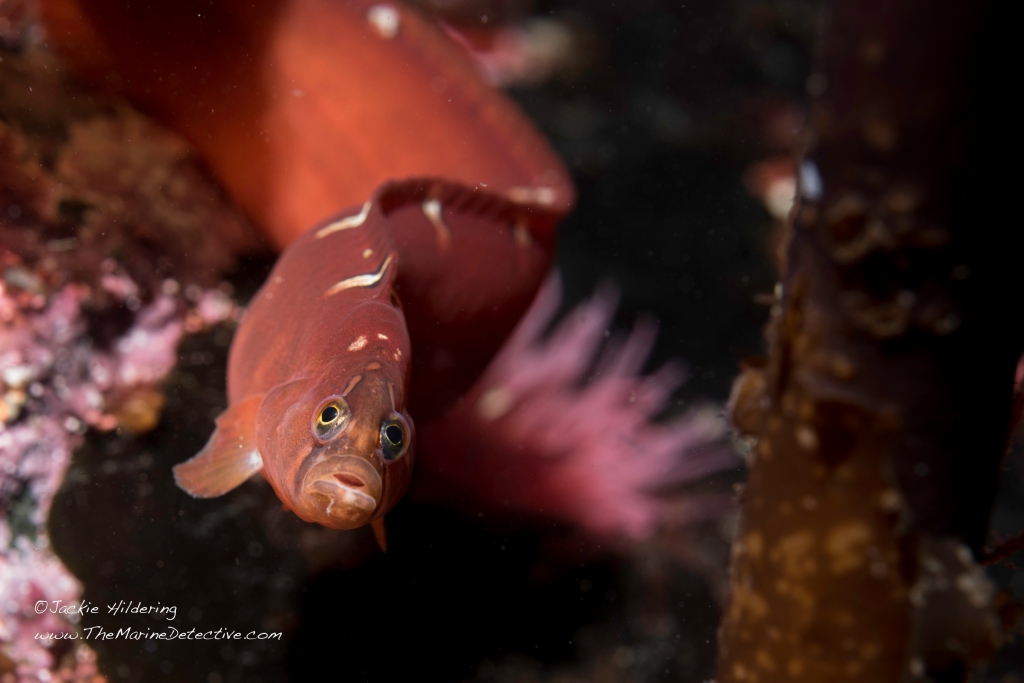
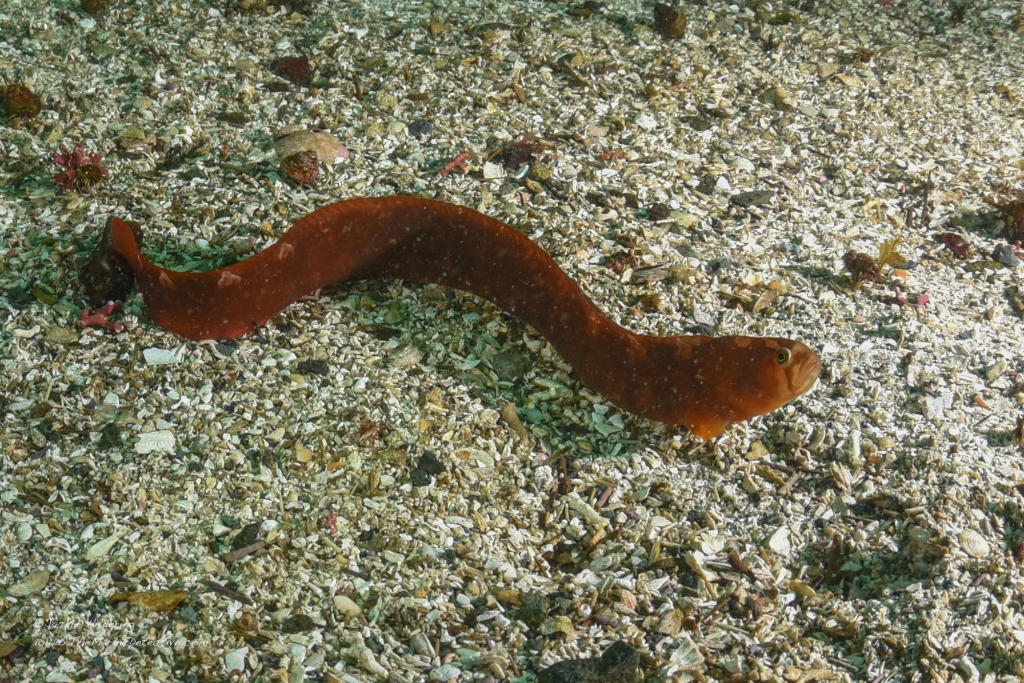
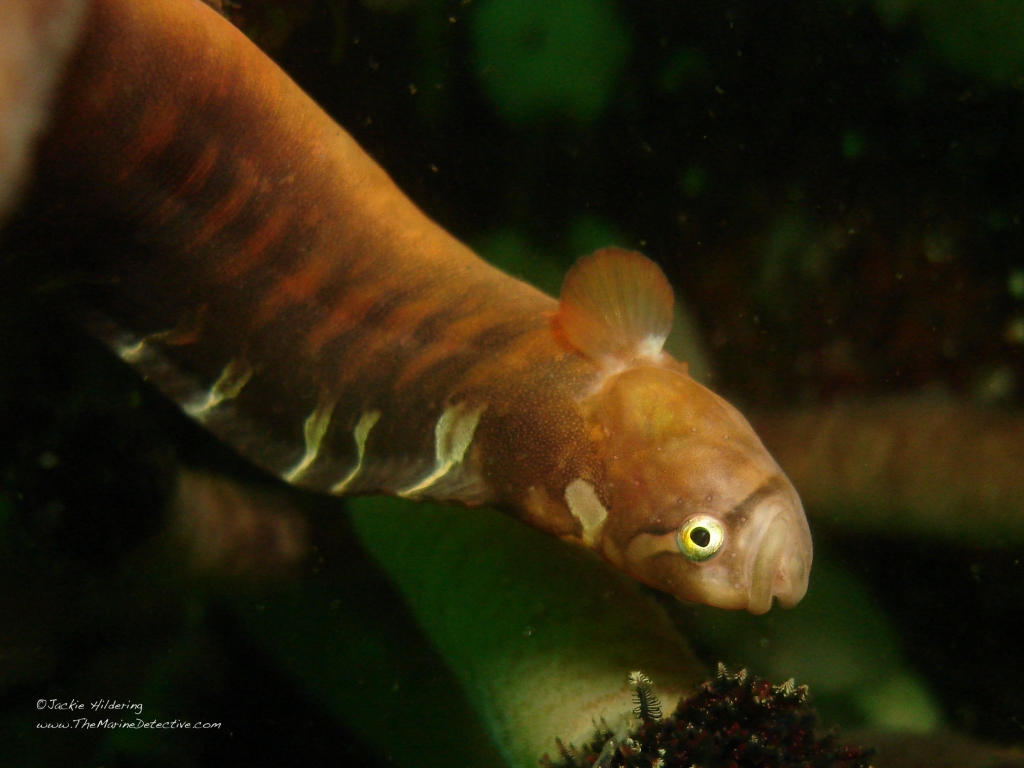
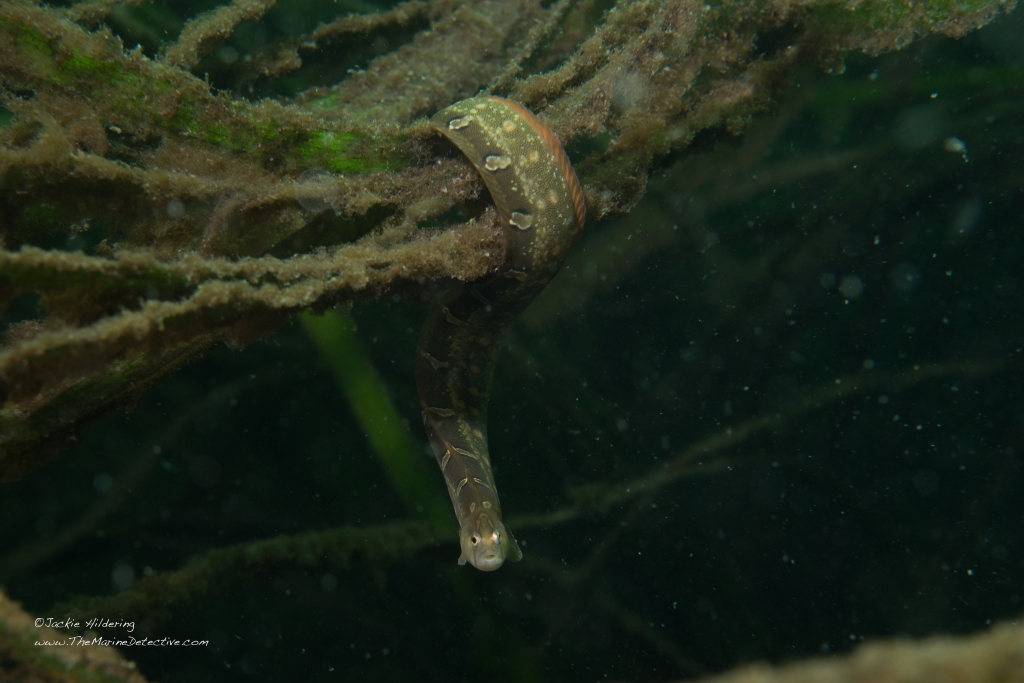
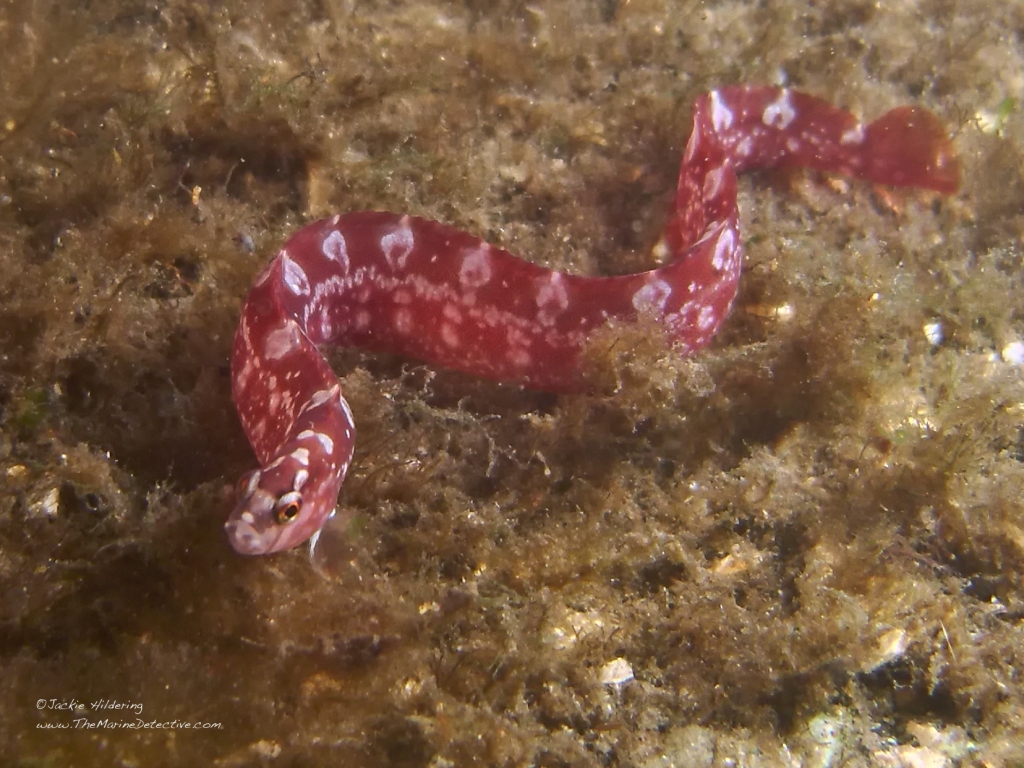
Many of you may know that every Friday I do a “Find the Fish Friday’ challenge and have two children’s books by the same name. These are the “Where’s Waldo” of the fish world with the intent being that, when people search for the fish in my images, they are also absorbing what the life looks like in the dark, rich Northeast Pacific Ocean.
Below are three such challenges where there is one fish to be found in each photo and it is a Penpoint Gunnel. At the very end of the blog I reveal the location of the fishes. Enjoy!

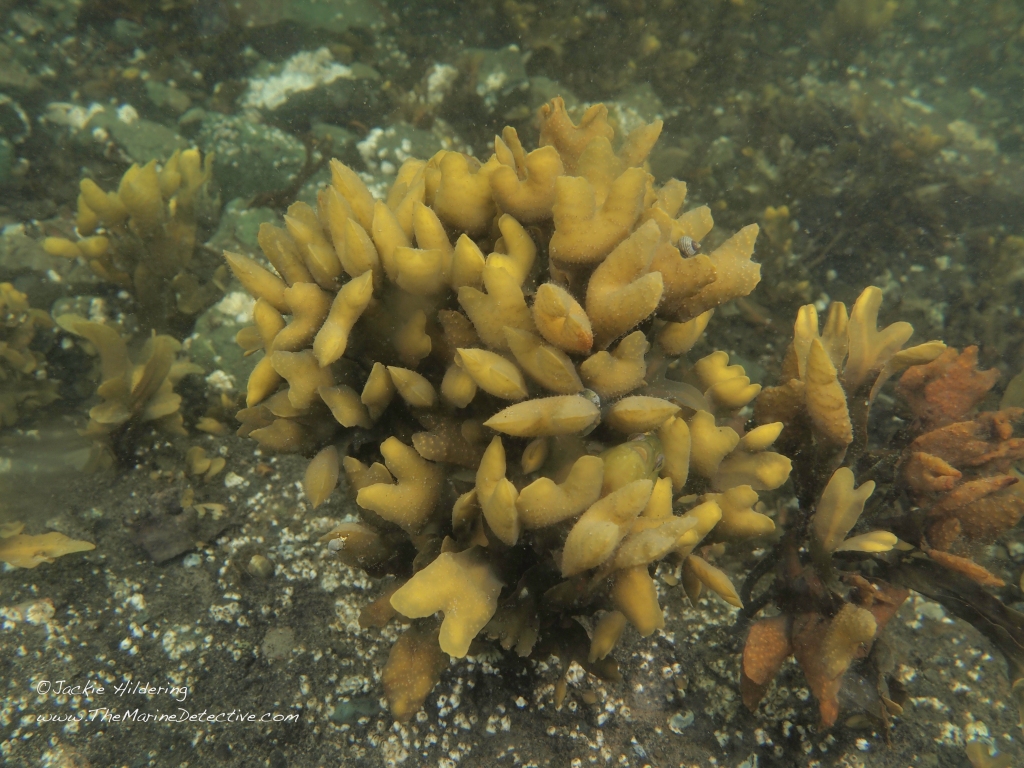
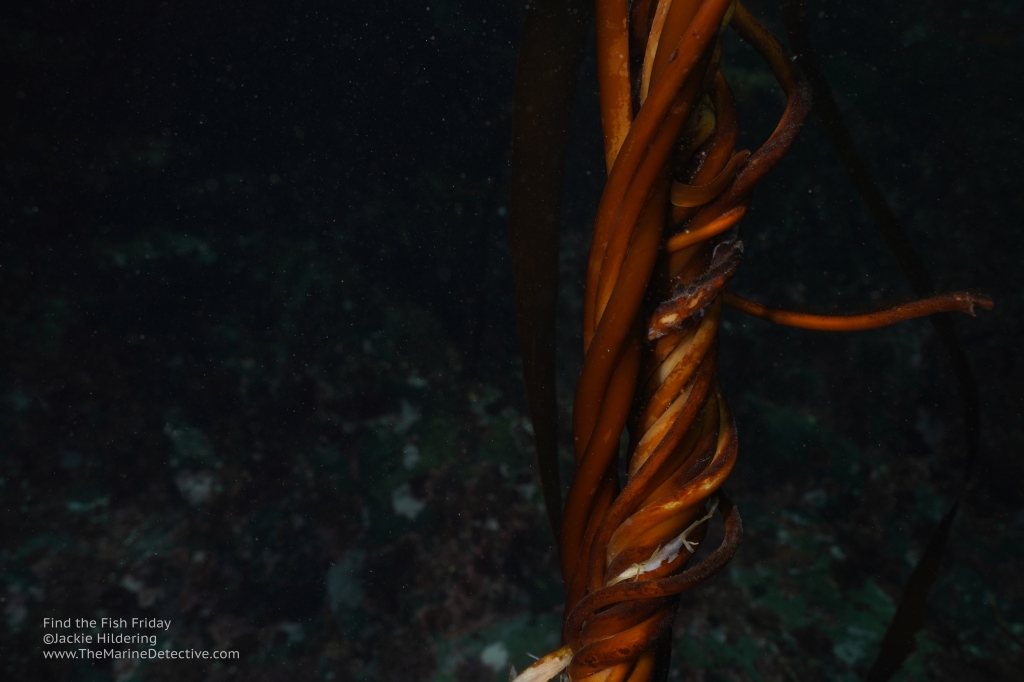
Species information from “Certainly More Than You Want to Know About the Pacific Coast” by Dr. Milton Love includes:
Maximum length to 46 cm. The Ranges: Kodiak Island to Santa Barbara and Gaviota (Southern California). They are abundant from at least Prince William Sound (northern Gulf of Alaska) to Central California. Intertidal to 8, including tide pools. Most fish live int he intertidal or barely subtidal . . .
Penpints are long, thin, and eel-like, distinguished by a deeply grooved spine on the front of the anal fin (hence the name “penpoint”), a line extending downward through the eyes, and no pelvic fins. The body colour is highly variable: orange, red, and magenta, bright green, olive, or bronze. While usually a solid colour, the body can be highly mottled, with a row of dark or light spots along the midline . . .”
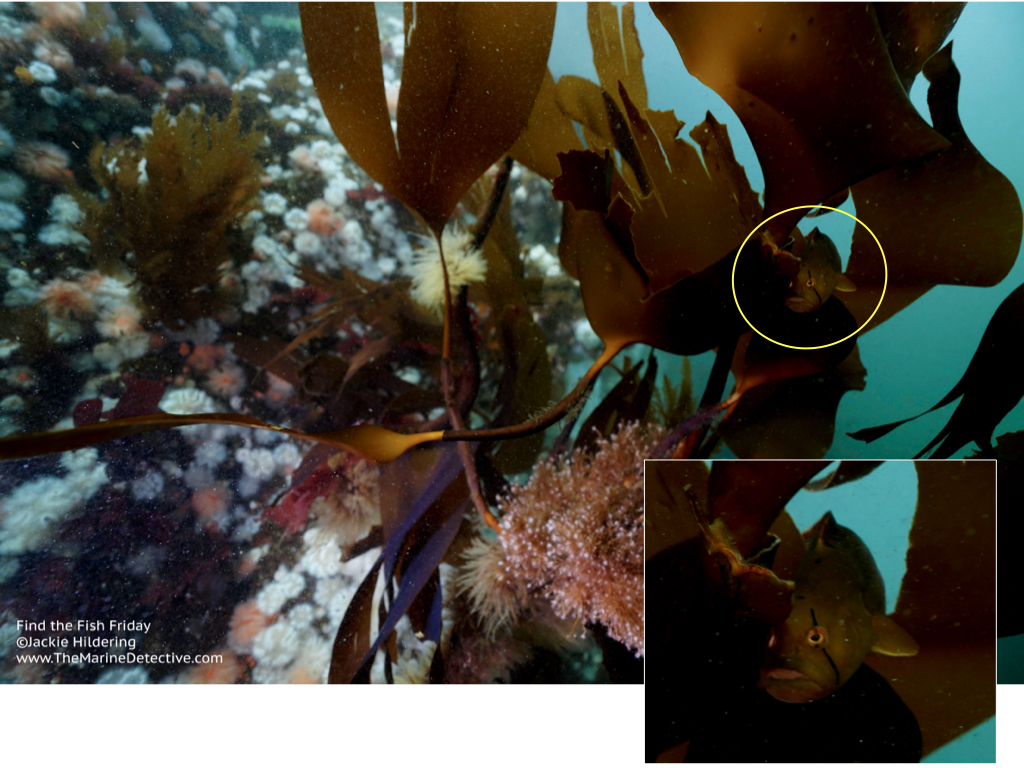

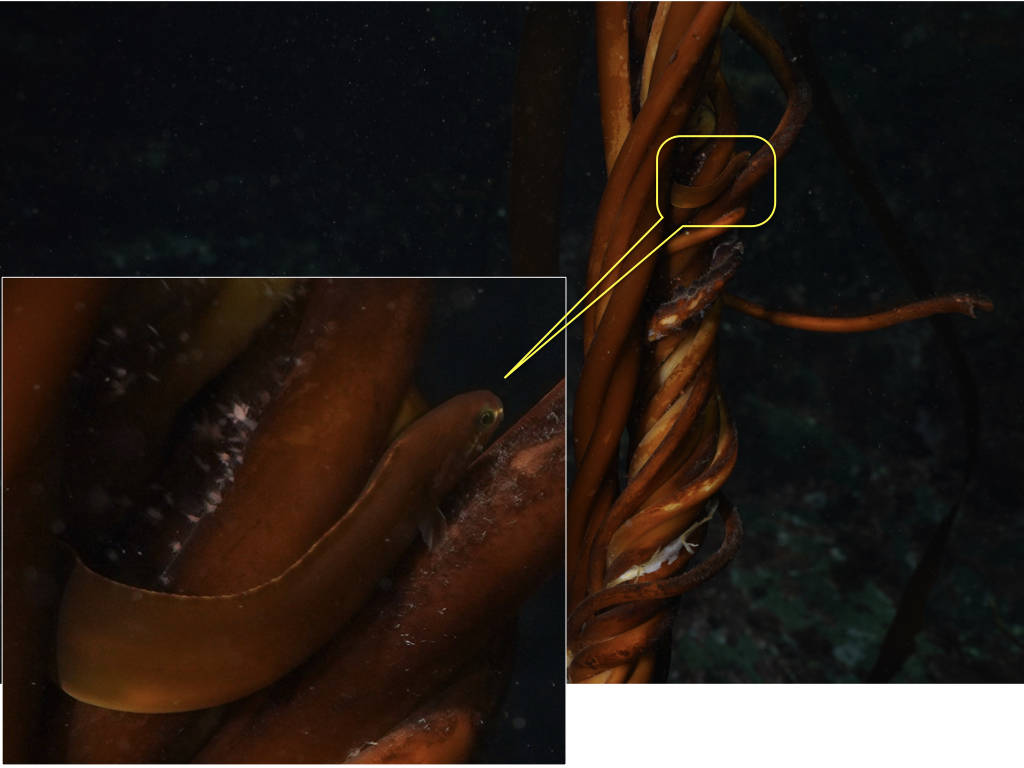
I have reached the pinnacle of what I could have hoped for in my life. The apex! The summit! ☺️
A finger puppet has been made of me AND it has been coupled with Jacques Cousteau.
Yes, it’s the Jackie / Jacques finger puppet set made with love for our Marine Education & Research Society online auction by dear Kerri Reid.
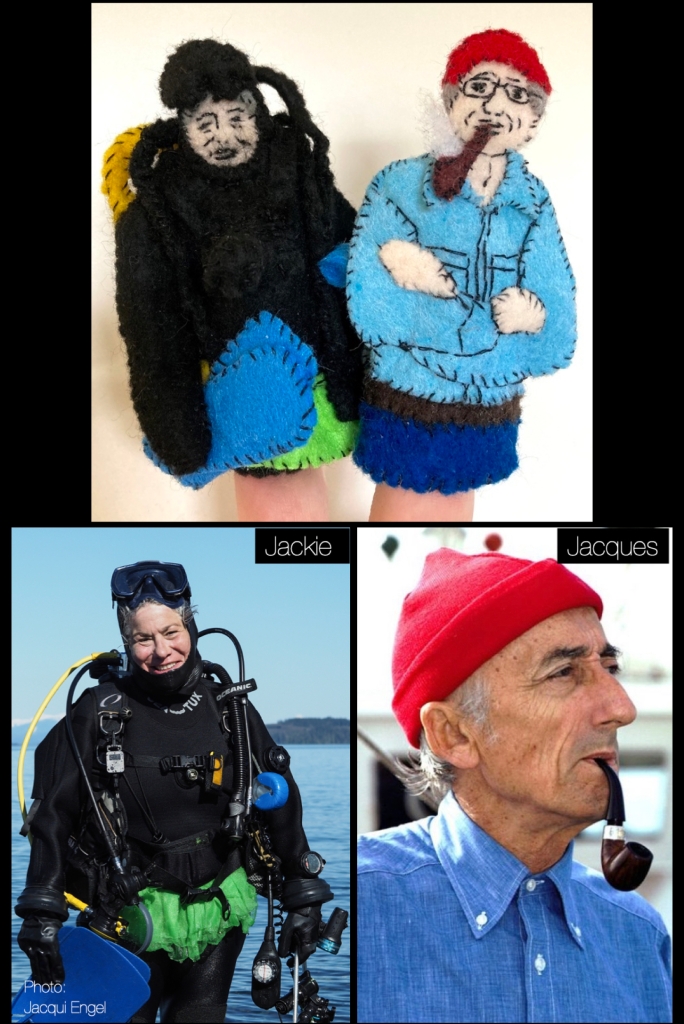
I am sharing this with you in part to make you smile but also, to let you know about this auction that is so essential to the work we do as the Marine Education and Research Society.
Please see ALL the unique, marine-themed, sustainable goodness in the online auction at this link.
And to Kerri, one billion thank yous for all the joy this brings. 💙
#LifeGoals
#selfmockery
______________________________
About Kerri:
Kerri Reid is a visual artist living in Sointula where she co-runs the Sointula Art Shed, a small artist residency/window gallery/project space. She has a BFA from Emily Carr and an MFA from the University of Guelph; has participated in shows and residencies nationally and internationally; and has taught art at OCAD, the Toronto School of Art, and the University of Guelph. She is also a mom who works part-time from home for the Living Oceans Society.
Her descriptor of the finger puppets: “That’s Jacques Cousteau casually smoking his pipe and wearing his signature and very stylish red toque, hanging out with the one and only Jackie Hildering aka The Marine Detective in her scuba gear with her infamous green tutu. ☺️ ”
I am so grateful for having been interviewed by Sheryl Mackay for CBC Radio’s North by Northwest and for how she captured the messaging for conservation.
This has led to a significant spike to my website and to social media channels which means . . . more reach of this work.
Welcome to all who have found their way here through their interest in, and love and concern for, the life-sustaining Ocean. 💙
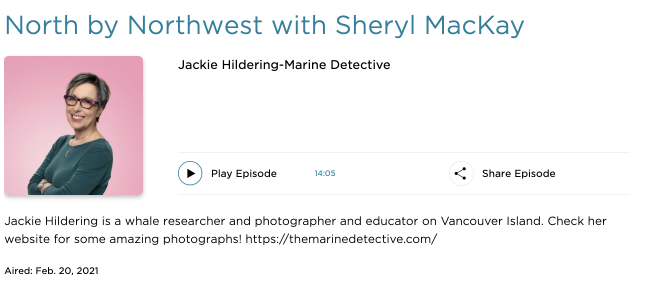
Please click to hear the episode.
Social media links.
Today is World Whale Day.
The following is what I wrote for our Marine Education and Research Society social media.
I am sharing it here too in the hopes that it is of value to you in thinking about our giant neighbours, how far we come in overcoming fear and disconnect but . . . read on. 💙
[And welcome to all those landing here as a result of the recent CBC interview. It would be wonderful if you follow along on social media with The Marine Detective and the Marine Education and Research Society. Links are at the bottom of this post.]
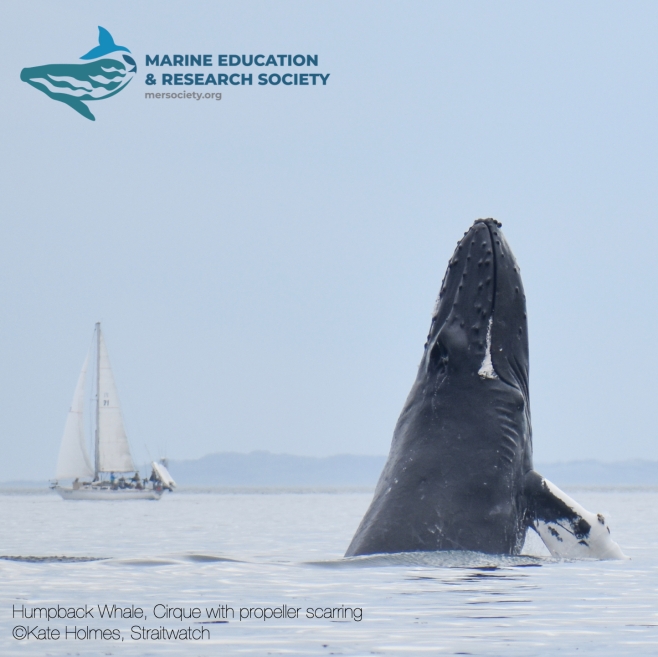
Take but a few minutes to reflect on the giants; how they enrich life on earth and how endure human need?
They inspire awe, capture carbon, fertilize the ocean upon which our lives also depend, and remind us of our capacity for change.
So many were driven to the brink as a result of whaling, which only ended in British Columbia in 1967. They have survived the breadth of human impacts from harpoons and guns, to overfishing and ignorance of ecosystems, to capture and the selfie absorption of believing wild whales put on shows.
Some populations may topple still.
Now they swallow the consequences of our disconnect and consumer crazed lifestyles – climate change, plastics, toxins, continued overfishing, noise, collision, entanglement, etc.
The leviathans, may we truly understand how they are barometers of our value systems, indicators of environment health, ambassadors of the marine ecosystem that sustains life on earth, and reminders of how little we know and that we are but small . . . in the world of the whale. ![]()
©Kate Holmes, Straitwatch 2019. Photo taken with a telephoto lens and has been cropped.
Social media links.
Thank you so much for your interest!
Following on the success of my blog answering the important life question: “How do octopuses poo?“, it’s high time I address “How do octopuses mate?”
Why? Because truly, by having better understanding of the adaptations of species that look so different from us, I believe we can be better humans.
What has catalyzed this blog finally being written is the following video by fellow diver Mel Vincent with buddy Jerry Berry. On a night dive, what they thought was one Giant Pacific Octopus, turned out to be two AND evidence that they had likely mated. The evidence is the empty “spermatophores”.
Spermatophores? The name gives you a good sense of what those might be, they are the rope-like sperm packets of a male octopus.
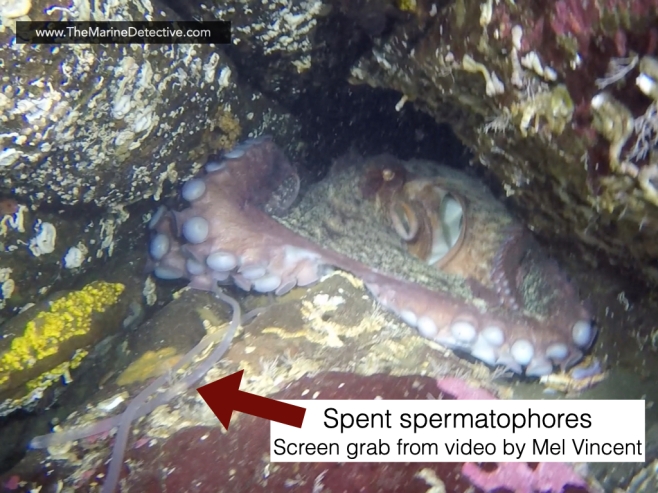
This is most likely the female although in neither can the 3rd arm on the right be seen to confirm if there is a hectocotylus arm or not. Giant Pacific Octopuses are Enteroctopus dofleini, the largest octopus species in the world.
Male octopuses have a specialized arm with no suckers at the tip called the “hectocotylus arm”. In Giant Pacific Octopuses, the hectocotylus arm is the third on the right. The section at the top which has the spermatophores is called the “ligula”. This section does not have the cells that allows colour and texture to change (the chromatophores). So the males often keep it curled up which helps discern males and females i.e. look for a curled up arm.
The spermatophores are made inside the male and the male grabs them by passing the hectocotylus arm into his body through the siphon when it is go time. It’s not a fast process. Apparently it takes about an hour for the sperm to move to the top end of the spermatophore. The spermatophores pass down a grove in that arm helped by cilia. Ultimately the spermatophores are ejected by the ligula and the shape of the spermatophore (and swelling inside the female), lock it in place in the female.
Where to “deliver” the contribution to the next generation in a female octopus? Through her siphon, to her oviduct(s). The swollen end of the spermatophore then bursts and the female stores the sperm in her “sperm receptacle” till ready to fertilize and then lay her eggs. Reportedly, about 40 days after copulation (delivery of the spermatophores) the female attaches up to ~68,000 fertilized eggs to the top of the den she has chosen . . . to be her last.
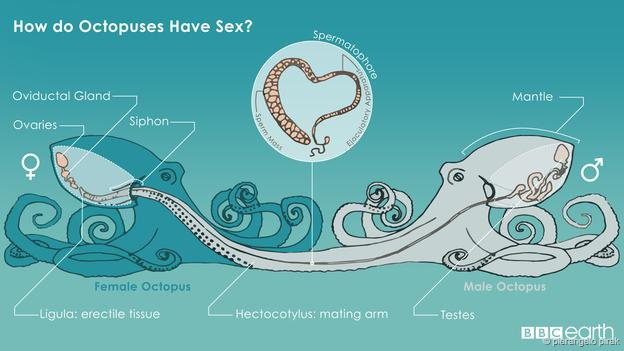
Credit: Pierangelo Pirak Source: BBC article on octopus sex
In Giant Pacific Octopuses, a spermatophore can apparently be up to 1 meter long and contain over four billion sperm. Usually two spermatophores are involved in one copulation. Such large numbers of sperm, and eggs, are needed when your babies hatch into the soup of the ocean. But mother gives them a fighting chance. Read on!
The spent spermatophores apparently may hang from the female for a while so can it be known for sure that the two Giant Pacific Octopuses Mel documented had just mated, or mated at all? It can’t be known definitively but with there being two octopuses, and that they had been interacting, it does suggest that mating had occurred. It certainly is extraordinary to have chanced upon the spermatophores of wild Giant Pacific Octopuses.
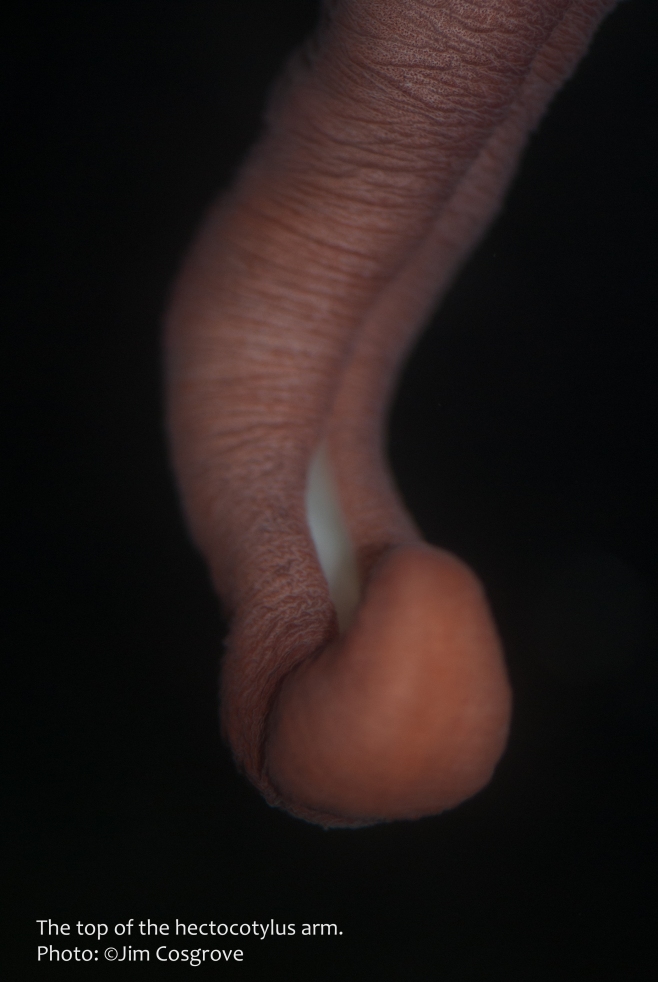
Top of a male Giant Pacific Octopus’ hectocotylus arm (ligula). Photo ©Jim Cosgrove.
I am very grateful to Jim Cosgrove, Neil McDaniel and Harbour Publishing for permission to include the following text on reproduction in Giant Pacific Octopuses from their book “Super Suckers – The Giant Pacific Octopus and Other Cephalopods of the Pacific Coast. It’s SUCH a good resource.
“FINDING A MATE…OR NINE?
When a female giant Pacific Octopus is ready to mate, it appears that she selects a den and attracts males to her. There is no conclusive evidence on how the female entices males, but there are strong indications that she produces some sort of chemical attractant. There are several reasons for believing this to be true.
The first reason is that giant Pacific octopuses are ordinarily solitary, and a smaller female would normally avoid a larger male that might attack and eat her. Jim has seen as many as nine males, however, in the immediate proximity of a female in a den. The males were scattered around the den and appeared to be unaware of each other, as there were no interactions amongst them. This was most unusual.
The second reason is that Jim has observed and seen video of large males standing atop prominent rocks. The octopus faces into the current and spreads out his arms like an open umbrella, turning slowly back and forth as the current flows past. We know that octopus suckers are sensitive chemical sensors, so it’s likely that the male tastes the water flowing past. His slow turning may enable him to identify the direction of the female’s attractant.
How the female selects a male—and whether she mates with one or more than one male -are still unknown. Jim is currently working with a genetics professor at the University of Victoria to try to resolve these questions.
Once a female selects a male, there are several ways in which the male transfers sperm to her. Sometimes the male mounts the female, almost completely covering her. In other cases the male merely extends his hectocotylized third right arm into the fe male’s den. Although the actual transfer of sperm requires only two to four hours, the mating process can last several days, so divers have a considerable handicap when trying to observe such behaviour. Indeed it is a rare event to witness a mating pair, and Jim has only seen nine matings. This is one situation in which observations in an aquarium are far easier than those in the open ocean. An aquarium researcher can set up a video camera and organize teams to watch the process on a 24-hour schedule until the event ends.
Jim, along with three other researchers, has combined experiences from open ocean and aquarium observations to produce a publication about giant Pacific Octopus matings. The study revealed that the male and female mate for approximately four hours and that repeat matings have been observed. In aquariums there is usually only one male in the tank with the female, so questions about multiple males and how the female selects a particular mate remain unanswered.
The male passes the female an elongated package of sperm called a spermatophore, which may be up to one metre (three feet) long, which he deposits in one of the female’s two oviducts. It is believed that when mating the male actually places two spermatophores in the female, one at the entrance to each oviduct. At this time the female is not yet pregnant—the term really does not apply to invertebrates anyway—but she has stored the sperm and will head off to find a suitable den to lay her eggs. The male, if he still has unused spermatophores, may try to find another female.
Thę den the female selects is usually deeper than 20 m (66 ft). Jim has noted that dens where previous females have nested were reused 41 percent of the time. These preferred dens tend to be under large flat rocks that provide a suitable overhead surface for the female to attach her eggs.
Once the female selects the den, she sometimes fortifies it by gathering rocks from the surrounding area and dragging them to the den. She often piles them up to create a wall of boulders that keeps out predators. A few days to a month may elapse between mating and selecting and preparing a den.
LAYING THE EGGS
Now the female begins to lay her eggs. She turns upside down and clings to the roof of the den while she lays the tiny eggs one at a time. Each egg is produced in the ovary and coated with rich yolk to provide energy for the developing embryo. At this point some sperm is used to fertilize the egg, and it is coated with a material that hardens into a rubbery, semi-opaque shell. Each egg is extruded individually through the funnel and grasped by the small suckers that surround the mother’s mouth.
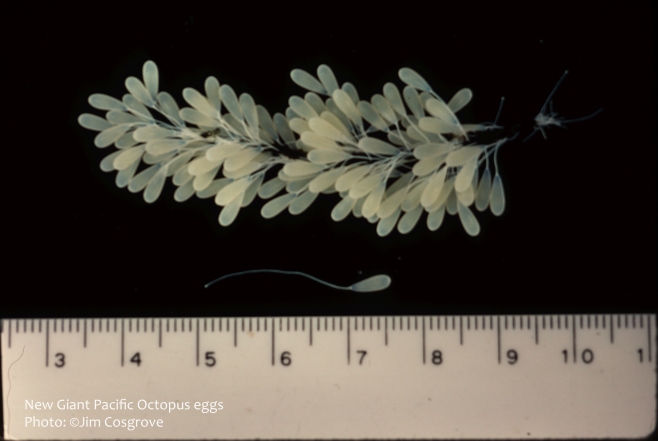
The body of the egg is a mere six millimetres (0.2 in) long about the size of a grain of rice—with a slender tail that adds another 11 mm (0.4 in), making the total length of the egg about 17 mm (0.7 in). The mother’s small suckers deftly manipulate the tail of the egg along with the fails of other eggs and weave them together into a slender string. She produces a secretion and applies it to the tails to bind them together. Over a period of three or four hours, while hanging upside down, the female produces a string containing an average of 176 eggs. Having glued this string to the roof of the den, the female descends to rest before returning to lay another string.
Eventually, over 28 to 42 days, the female will produce a complete nest of about 390 strings with approximately 68,000 eggs.
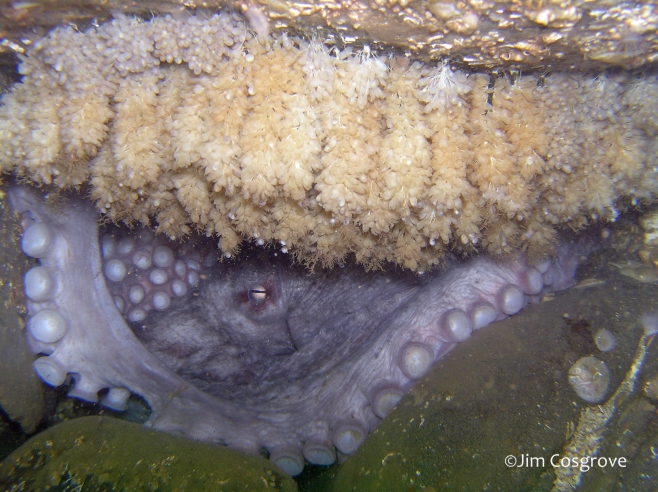
Female Giant Pacific Octopus tending her eggs. Photo ©Jim Cosgrove.
NESTING BEHAVIOUR: THE LONG WAIT
Once the female has finished laying, she spends the next 6.5 to 11 months tending the eggs. She grooms them with her suckers to ķeep them free of bacteria and other organisms that might damage them. Usually she is not completely successful, as often some eggs are encrusted by colonial animals called hydroids and do not hatch.
The female blows water through the strings of eggs with enough force that they jostle around. This helps keep them clean and free of growth and will be critical when the eggs start to hatch. She also protects the nest against predators such as sea stars, not always successfully. Mottled sea stars (Evasterias troschelii) have been observed robbing egg strings from a den.
Video above by Laura James of a mother Giant Pacific Octopus tending her eggs.
Other creatures enter the nest but do not appear to do any damage. These include small worms, snails and crabs such as the longhorn decorator crab (Chorilia longipes) and the sharpnose crab (Scyra acutifrons).
While the female tends her eggs, she does not feed. We don’t know the exact reason for this, but one suggestion is that if the female left the den to hunt, she would leave the eggs unat tended and vulnerable to predators. Another suggestion is that the presence of food scraps in or near the den might attract predators. Jim does not subscribe to either of these theories. Because this behaviour is common to many cephalopods, he believes it is more likely linked to an ancestral trait, the reason for which may no longer exist. This is an example of innate behaviour, part of the hard-wired information an octopus is, born with.
The development of the embryos depends on the surrounding water temperature. The colder the water, the slower the develop ment; the warmer the water, the faster it proceeds. This is true among most egg-laying marine invertebrates.
Jim has been able to observe much of the development in the wild and develop a time frame for estimating when hatching would occur. If he was lucky enough to have witnessed the egg laying, he would have a pretty accurate idea of how the eggs would look as they developed. In most cases he did not see the egg laying, however, and would have to observe the eggs for signs of development to predict when they would hatch.
WATCHING THE EGGS: A DIVER’S VIEW
Newly laid eggs are glossy white and look like white raindrops. The core that the eggs are woven into is pale green, but within a few weeks the core turns black and remains so.
Two small red dots appear on each egg about 120 to 150 days after the eggs are laid. These dots, the developing eyes of the embryo, are visible through the egg shell. The eggs are no longer as shiny white, and soon one can see the brighter yolk sac in the large end of the egg and the darker developing embryo at the small end.
About 180 to 210 days after the eggs are laid, the embryo has used up much of the yolk, and the size of the yolk sac has de creased while the size of the embryo has increased. So that the embryo can continue growing, it moves into the larger portion of the egg. This is actually the second reversal, but it is the only one that a diver can observe.
Over the next few months a diver can watch as the yolk sac becomes smaller and the eggs become darker. Those with sharp eyes may be able to see the movement of the embryo within the egg and the flashing of brown and white colours as the embryo tries out its chromatophores.
About 240 to 270 days after the eggs are laid, hatching occurs.
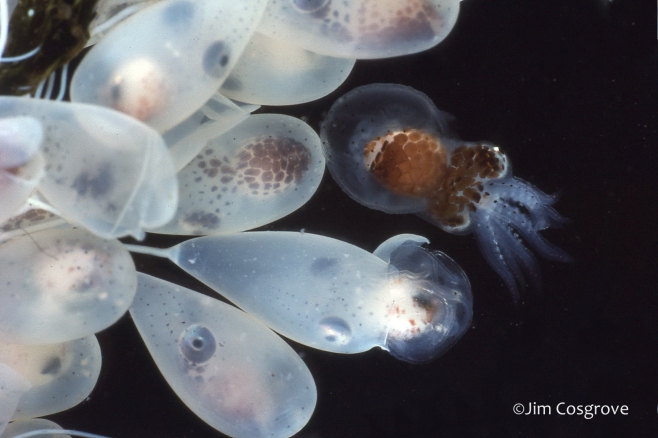
Giant Pacific Octopuses hatching. Photo ©Jim Cosgrove.
THE NIGHT OF THE HATCH
It might seem logical that the eggs would hatch over the same period of time and in the same order as they were laid. This does happen in many octopuses, including the giant Pacific octopus, but not always. Jim has witnessed a number of hatchings in which he has seen the nest intact one day and completely hatched out the next morning.
Jim collected strings of unhatched eggs from time to time and took them to his lab. When observing the eggs through a dissect ing microscope, he found that the water surrounding the eggs was warmed by the microscope lights, often causing the eggs to hatch. He probably collected strings of eggs that had not been laid at the same time, yet even eggs from different strings hatched nearly simultaneously.
Some type of chemical released from a hatched egg stimulates other eggs to hatch as well, Jim suspected. The embryos often had different amounts of food remaining in the yolk sac below their mouth. In some cases the yolk sac was consumed, but in others the yolk sac was still large enough that the paralarva had to bite it off. Clearly some of the paralarvae were not as well developed as others but were able to survive even if they hatched somewhat prematurely.
The hatch normally occurs at night. It may start at dusk, but often it is several hours after dark before things really get under way. As the eggs hatch in ever-increasing numbers, the female blows strongly onto the strings of eggs, causing them to thrash around. This helps the paralarvae to pop out of the eggs and aids in flushing them away from the den.
MOTHER’S JOB IS DONE
In most cases the female survives the hatching and lingers in the den for another few weeks before she dies. During the entire nesting period, which may have dragged on as long as 11 months, the female has not eaten. By hatching time she has lost more than 60 percent of her body weight, sometimes as much as 85 percent! Even though the eggs have hatched the female continues to “mother” them as before. She grooms the hatched-out egg cases even though the paralarvae are long gone.
Experiments have been done in which the eggs have been re moved from the ovary of a mated female. Incredibly the female went through the entire egg laying and grooming process, even though she had no eggs or nest. This “phantom nesting” shows that a behavioural lock and key is triggered at sexual maturity or at mating.
In some cases the female does not have enough energy stored to survive the whole nesting period and dies before the eggs hatch. Usually her last act is to vacate the den and crawl away. She usually only moves a metre or two before she dies. Again there is no solid evidence on why the female va cates the den, but Jim sub scribes to the theory that if the female died in the den her de composing body could foul the water and attract scavengers.. One can understand that fe males not leaving the den might have resulted, in an evolution ary sense, in the nest being dis covered and eaten. This would result in the failure of her genes to be passed on to successive generations. The genes that were passed on would be those of females who successfully distracted predators away from the nest.
While this strategy is interesting, it is not totally successful. In several cases where the female died before the eggs hatched, even though the embryos developed properly, the eggs did not hatch. Without the agitation provided by the female blowing wa ter over them, the closely packed eggs remain immobile and pressed against each other. As a result the paralarvae are unable to force their way out of the eggs, and most perish.
Jim found it sad to observe nests where only a partial hatch was successful. As he counted strings and eggs, he often found thousands of dead paralarvae. Sometimes nature seemed harsh and wasteful.”
Video below by Laura James of Giant Pacific Octopuses hatching and mother dying.
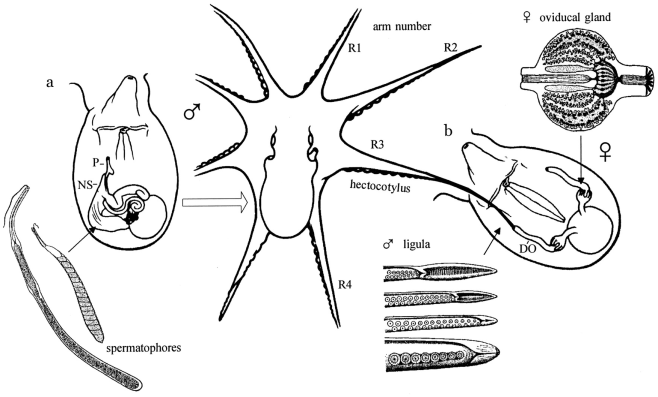
Male anatomy on left and female on right. Source: Hanlon, R., & Messenger, J. (2018). Reproductive Behaviour. In Cephalopod Behaviour (pp. 148-205). Cambridge: Cambridge University Press. doi:10.1017/9780511843600.008
Further detail on mating in Giant Pacific Octopuses from “A Snail’s Odyssey”
“After a short courtship, the male Enteroctopus dolfleini grabs the thin or distal end of a spermatophore from its penis using the groove in its hectocotylus arm and thrusts it into the orifice of one of the female’s oviducts. This initiates a complex series of events within the spermatophore that cause the sperm rope to be pushed into the thin or distal end, which swells to accommodate the incoming load of sperm and leads to evagination of the ejaculatory apparatus (see illustration on Left). This action locks the sperm-filled swelling in place within the oviduct and prevents it from dropping out of the female. The sperm rope is moved along by pressure from seawater diffusing into the proximal end of the spermatophore and from elastic contraction of the sperm rope itself. The movement takes about an hour. These actions haul the entire mass of tightly encapsulated spermatozoa over a distance of a meter from the proximal to distal end of the spermatophore. The sperm are now positioned in a swollen bladder or reservoir located at what was previously the thin or distal end of the spermatophore (see photograph on Right). The next step, evagination of the ejaculatory apparatus, occurs suddenly and produces a crink in the tube that locks it in place in the oviduct. The locking-in may additionally ensure that spermatozoa are not lost in “back-flow” from the oviduct. The swollen end of the spermatophore now bursts and the sperm are moved into the female’s sperm receptacle for later use. The process is repeated with a second spermatophore. About 2-3h after the arm is first inserted and after repeated pokings, the female has two empty spermatophores hanging from its oviducal orifices.”
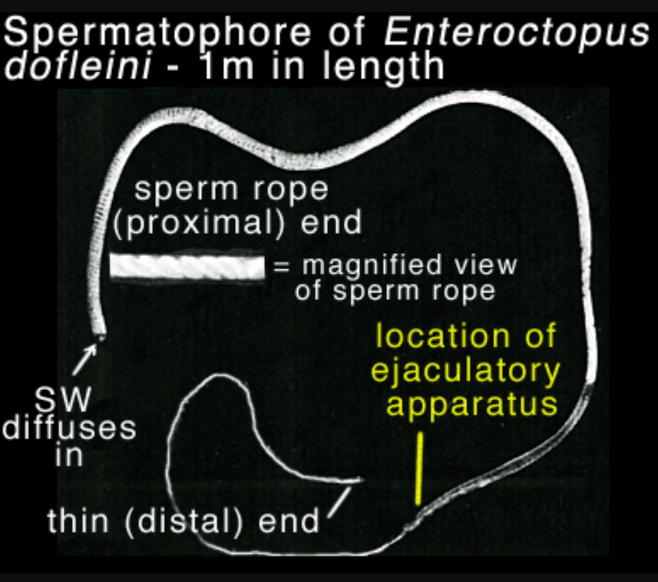
Source: Mann et al. 1966. Nature 211: 1279. Retrieved from https://www.asnailsodyssey.com/index.php?x=469 on 2021-02-06. SW = seawater.
Sources:
[Note: Text below has been corrected / edited on January 5th. Corrections are marked in red.]
Marine snails have doors. Freshwater snails do too.
Some tubeworm species have them as well.
Yes they do.
They all make an “operculum”. That means “little lid” in Latin but, I’m sticking with referencing the structure being like a door. 🙂
See the operculum in my photo of an Oregon Triton below? It’s the structure sealing off the entrance to the shell.
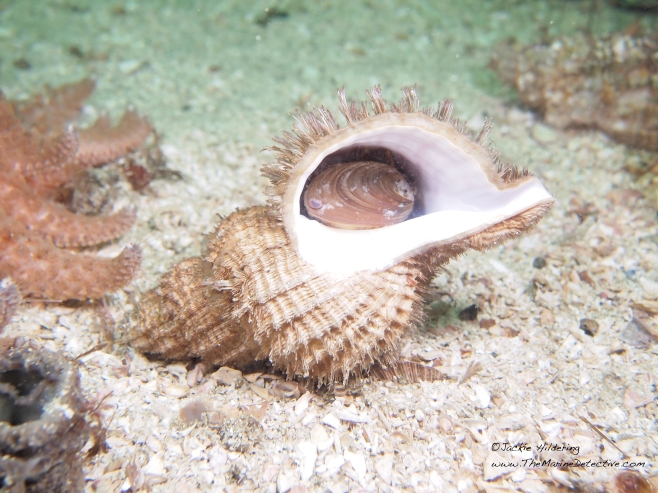
Oregon Triton (Fusitriton oregonensis). That’s a Sunflower Star on the left. With that species now being in such trouble, it’s a clue that this photo was taken before the onslaught of Sea Star Wasting Disease.
Oregon Tritons are a big marine snail species with a shell up to 15 cm long (and with a range well beyond Oregon ie. known from northern Alaska to northern Mexico, and Japan). You can imagine how, if the snail did not have the operculum, a predator could still get access to the snail in its shell.
Lewis’ Moonsnails are another really big snail. Their shell can be up to 14 cm wide and look at the size of their bodies relative to the shell!
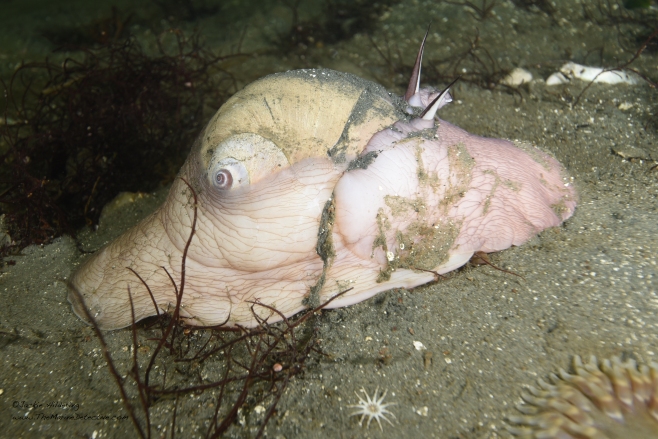
Lewis’ Moonsnail on the prowl (Neverita lewisii).
Even though they can release some water from their bodies to become smaller, they clearly need a big opening (aperture) to their shell to get back in.
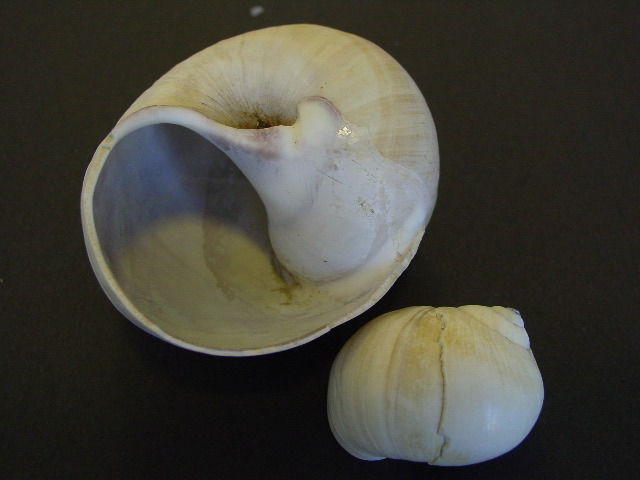
It’s a space you do not want to leave wide open. Hence, the need for making an operculum to seal that opening.

Operculum from a Lewis’ Moonsnail. Shape, strength and size is perfect to seal off the entrance.
For snail species that may be found in the intertidal zone, closing the shell with the operculum not only protects them from potential predation, it also may offer them some protection from drying out. Greg Jensen, author of Beneath Pacific Tides, thankfully offered the following knowledge correcting my previous statement about how useful the operculum might be for this purpose: “Marine snails don’t generally use their operculum to seal the shell at low tide. They snug themselves up tight to a rock with their foot.”
He also shared that land snails, who do NOT have an operculum, avoid drying out by coming out in the cool of night or when it is otherwise damp. Another adaptation is that, when it gets too dry, they glue their shells onto a hard surface, sealed shut with dried mucous to retain moisture.
Not only does the snail make this shell-like structure, it also grows with the individual. The operculum is attached to snail’s body so when the snail retreats, the door does its job. Not surprisingly, the shape of the operculum is a match for the size and shape of the opening, therefore varying between species. The three photos below show some differences.

Blue Topsnail with operculum (Calliostoma ligatum, shell to 3 cm across). Even really tiny marine snail species like Common Periwinkles have an operculum.

Leafy Hornmouth closing up with the operculum visible at the end of the snail’s foot (Ceratostoma foliatum, shell to 10 cm long). There’s a Three-Line Nudibranch on the upper right.

Purple-Ringed Topsnail with opecullum visible (near a Green Urchin). Calliostoma annulatum, shell to 4 cm wide)
But what about hermit crab species who use the snails’ shells once they die? Since the operculum was attached to the body of the deceased snails, are the hermit crabs left with a wide open door? Oh just look at how amazing nature is in making sure they too are protected within the shell. The photo below shows you why so many marine hermit crab species have one claw bigger than the other. The bigger claw seals off the entrance in lieu of the operculum!

Widehand Hermit in the shell of an Oregon Triton. Widehand hermit is Elassochirus tenuimanu.
Not all marine hermit crab species have this adaptation. Other options include choosing a smaller shell so you can “shake it off” and run like hell when threatened. It’s called the Taylor Swift strategy. I’m kidding! But let me know if you get the pop star word play.
I also mentioned that some tubeworm species make an operculum. See below. In the centre of the image there is a Red-Trumpet Calcareous Tubeworm (Serpula columbiana to 6.5 cm long).
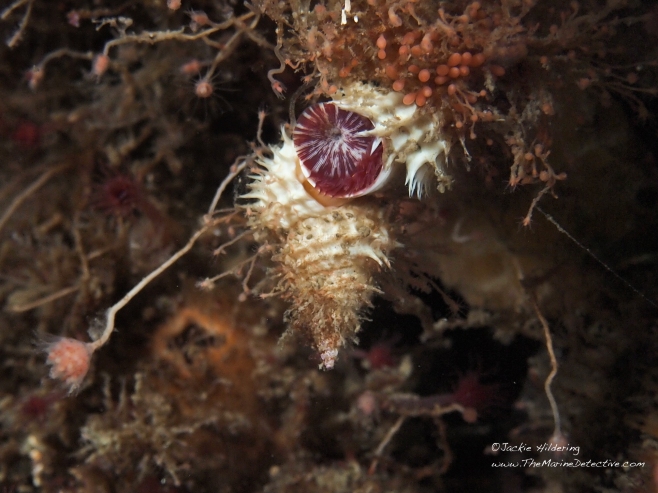
Red-Trumpet Calcareous Tubeworm in the centre (Serpula columbiana to 6.5 cm long) with two Checkered Hairysnails (Trichotropsis cancellata to 4 cm long).
As a tubeworm, the species captures plankton drifting by with its crown (radioles). As the common name indicates, the operculum in this species is trumpet shaped. For the individual in the photo, the operculum is purple with white stripes.
I had initially stated that there’s a really good reason for this species to have the door and you are looking right at it. Those snails are kleptoparasites. “Klepto” as you likely know, means to steal (from ancient Greek). The Checkered Hairysnails use their long mouthparts (the proboscis) to try to suck up the food the worm captures before it gets to the worm’s mouth. HOWEVER, what I also learned from Greg Jensen is that the theft by the Checkered Hariysnails is apparently so stealth, that the tubeworm does NOT respond to their mouthparts by closing its operculum.
Thereby, the operculum may help these tubeworms protect their crown (and other body parts) but does not protect them from kleptoparasites.
But YOU know what to do.
Unwelcome guests? Shut the door!
All photos ©Jackie Hildering, taken near NE Vancouver Island.
There are times however where you want the door wide open IF you are a marine snail. The additional photos below include that information.

Oregon Tritons mating. That’s a time when you want opercula out of the way. Unlike may humans, they must mate with the door wide open. 😉
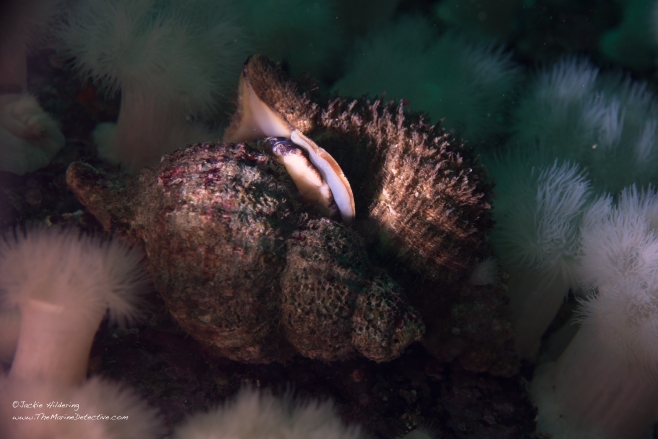
Two other Oregon Tritons mating, opercula to the side. Like the mood lighting? You’re welcome.
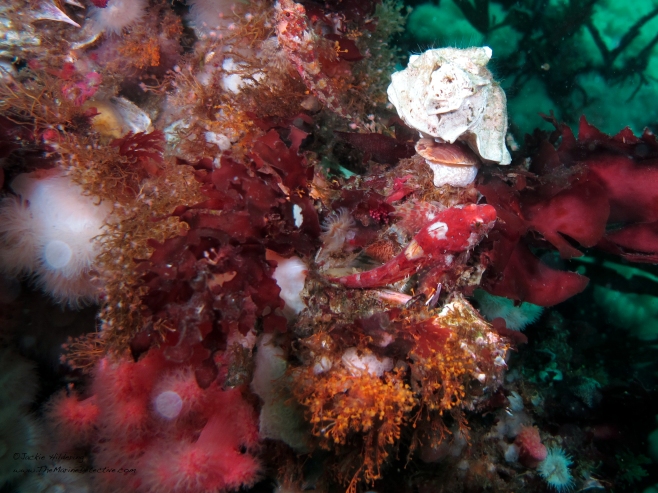
Another Leafy Hornmouth with operculum visible at the bottom of the snail’s foot. And yes, there’s a Scalyhead Sculpin here too.

Another Red-Trumpet Calcareous Tubeworm. This one is out of its tube. There’s great diversity in colour in the species. See the trumpet-like operculum on the right?
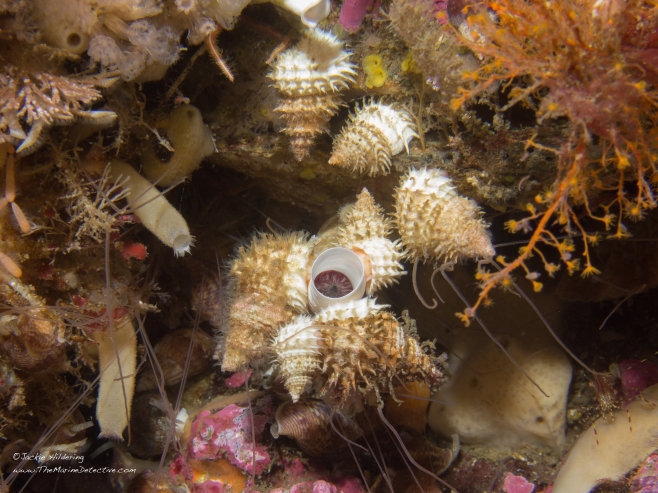
Oh oh. This Red Calcareous Tubeworm has 7 kleptoparasites near!